Samsung The Frame 2025 is a TV unlike any other – and even though competition has emerged for it, it still does it best. The matte display, flush mounting to the wall, and one thin cable thanks to the One Connect module make the device look more like a painting than any other screen. The Art Store app still offers the best scanned artwork on the market (even if it's subscription-based), and with interchangeable frames, we can adapt the TV to the interior almost like a piece of furniture. As for the image itself, because we are also talking about a regular TV, there are no significant changes, but also no disappointments compared to last year's model LS03D. The Frame still offers high native contrast and solid brightness at 600 nits, which combined with the matte coating provides very comfortable use during the day. The colors are not as vibrant as on glossy screens, but against the backdrop of competing matte constructions – it performs the best. A novelty is the 144 Hz refresh rate, though in practice, mainly PC gamers will benefit from it. And indeed – in terms of features for gamers, The Frame has almost everything: low input lag, variable refresh rate (VRR) support, automatic game mode (ALLM), Game Bar, and a unique motion smoother designed for gaming. Unfortunately, not everything is as perfect as it might seem. Why? Because the HGiG mode is suddenly missing from the latest version of the Tizen system. And here Samsung really should respond, as for many gamers this is a crucial element of screen selection. And we fully understand that. Although LS03F The Frame 2025 doesn’t bring major revolutions, it is still a unique TV that, apart from its appearance, offers quite a solid picture and extensive gaming features. It’s just a shame that year after year we also encounter new compromises.
- Matching (Score)
- Our verdict
- TV appearance
- Where to buy
- Contrast and black detail
- HDR effect quality
- Factory color reproduction
- Color reproduction after calibration
- Smoothness of tonal transitions
- Image scaling and smoothness of tonal transitions
- Blur and motion smoothness
- Console compatibility and gaming features
- Input lag
- Compatibility with PC
- Viewing angles
- TV efficiency during daytime
- Details about the matrix
- TV features
- Apps
- Playing files from USB
- Sound
Samsung The Frame 2025 (LS03F) vs Samsung QN85F
Direct compare
Check the best price offer:
Samsung The Frame 2025 (LS03F)The Frame / LS03FAU
QN85F

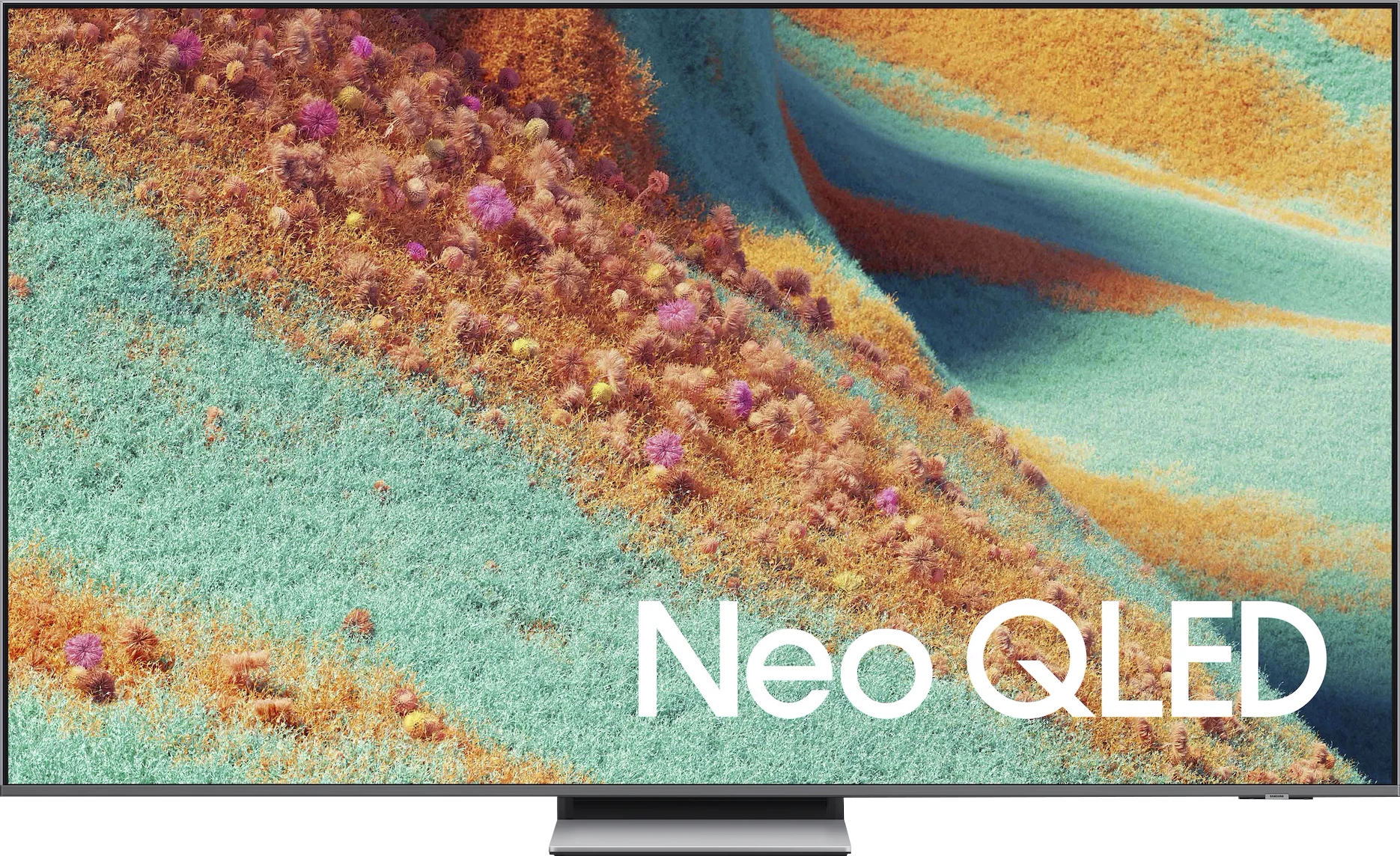
Panel type: LCD VA
Resolution: 3840x2160
System: Tizen
Model year: 2025
Complete the survey to find out the result

Panel type: LCD VA
Resolution: 3840x2160
System: Tizen
Model year: 2025
Complete the survey to find out the result

Overall rating
7.0
7.6
Movies and series in UHD quality
6.8
7.5
Classic TV, YouTube
6.5
7.2
Sports broadcasts (TV and apps)
6.4
7.0
Gaming on console
8.4
8.7
TV as a computer monitor
8.2
8.4
Watching in bright light
6.3
6.9
Utility functions
7.2
7.3
Apps
8.7
8.7
Sound quality
6.0
7.6
Complete the survey to find out what fits your preferences
Advantages
The matte display effectively reduces reflections
Customization options for the screen with interchangeable frames + art mode
Free accessories in the form of a wall mount + OneConnect module
High native contrast
Decent brightness
High refresh rate - 120/144Hz
Lots of features for gamers - VRR, ALLM, Gamebar, proprietary motion smoother working in games
High HDR brightness (even 1700–1800 nits)
Very good contrast and deep blacks
2 times higher number of dimming zones than its predecessor (55")
144 Hz panel with VRR and ALLM support
Original Game Motion Plus feature – a unique smoother in gaming
Low input lag
Satin finish of the panel works great during the day combined with high brightness
Extensive Tizen platform: with AirPlay, SmartThings, and convenient solar remote
Beautifully designed base. Hybrid – can be a central stand or side legs
Solid sound with pleasant bass and Dolby Atmos support
Disadvantages
No HGiG mode – makes it difficult to set HDR accurately on the console.
No DTS support – requires additional equipment for certain films from Blu-ray discs.
Paid image mode
No support for Dolby Vision and DTS:X
No recording function from built-in tuners and PiP
Issue with HEIC files in the player
No proper support for HGiG* in gaming mode
*This seems to be an update error that we hope Samsung will quickly fix. We are monitoring the situation for you continuously.
Our verdict
The Samsung QN85F is a television that perfectly demonstrates the purpose of the Neo QLED line. On one hand, it has everything a modern user expects – high brightness, excellent smoothness, and full support for gamers. On the other hand, it's still an LCD, which means the technology comes with certain compromises. The question is whether these compromises actually hinder everyday use? In practice, it's hard not to be impressed with how the QN85F performs in HDR movies. A brightness level of 1700–1800 nits makes watching dynamic scenes truly convey the "HDR spark" that many competing TVs lack. The lighting effects in movies or series can literally overwhelm with intensity, while the TV does not lose detail and does not turn the whole image into a washed-out blur. This is exactly the kind of spectacular quality that viewers investing in a new screen are looking for. Gamers also have reasons to be pleased. (Well, maybe aside from one limitation related to HGIG.) There is support for 144 Hz, variable refresh rate VRR, and auto low latency mode ALLM. This is already a must-have feature in this class, but Samsung goes further and adds a unique feature called Game Motion Plus. Thanks to it, the image in games becomes smoother, resembling the effect of motion smoothing in films, but without a noticeable increase in lag. This solution truly distinguishes the QN85F from the competition. Adding to all of this is everyday convenience. The Tizen system is fast, stable, and full of apps that we actually use – from Netflix and Apple TV to YouTube and Disney+. Additionally, there is AirPlay support, an advanced SmartThings platform, and a remote that, instead of overwhelming us with dozens of buttons, provides simple control and quick access to the most important functions. This makes the QN85F a TV that you simply want to reach for every day. Of course, it’s possible to list its shortcomings. There’s no Dolby Vision, no USB recording, or PiP, and the viewing angles typical of VA panels won't impress if you sit at a large angle. But all of this pales in comparison to how versatile and refined the QN85F is. During the day, it performs excellently in bright rooms, in the evening it delivers cinematic emotions in HDR, and in games, it provides smoothness and low input lag that other models could envy. Overall, the QN85F is a TV that not only successfully continues the value tradition of its predecessor, the QN85D, but even enhances it with several strong points. It's a device that’s hard to describe in any other way than as a "safe choice" – one that will not disappoint in any scenario and is highly likely to meet the expectations of even the most demanding users.
TV appearance





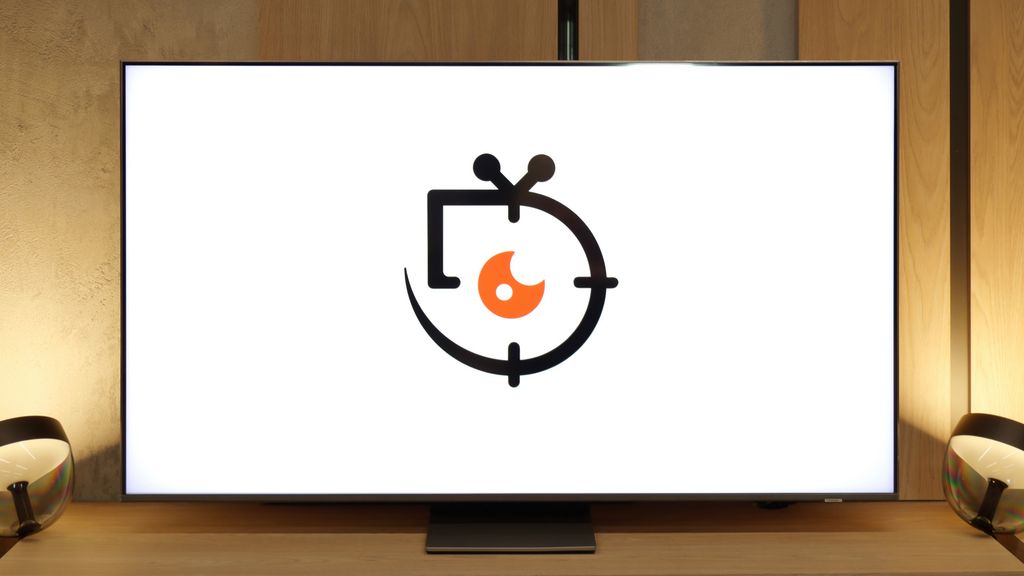
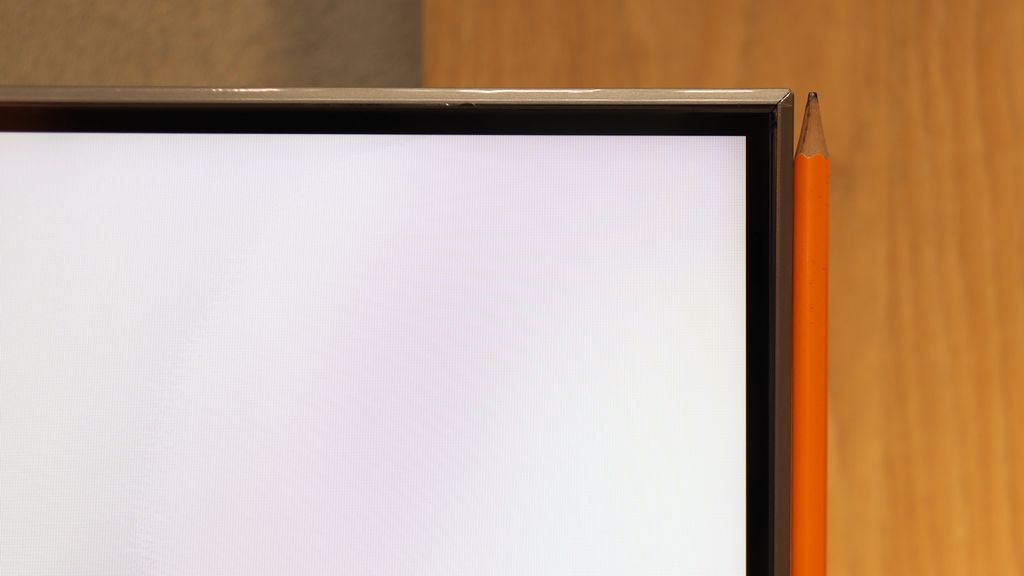
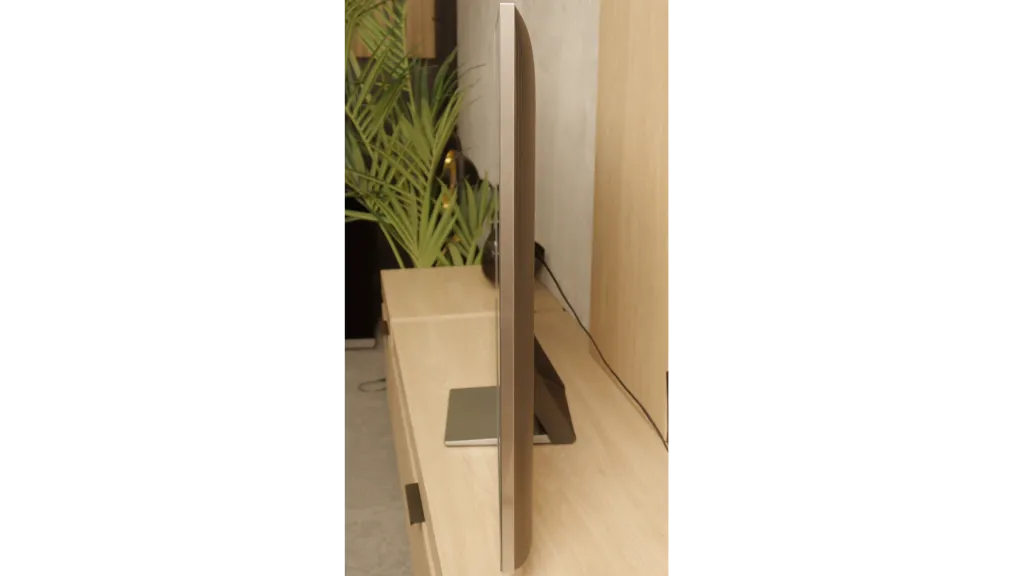
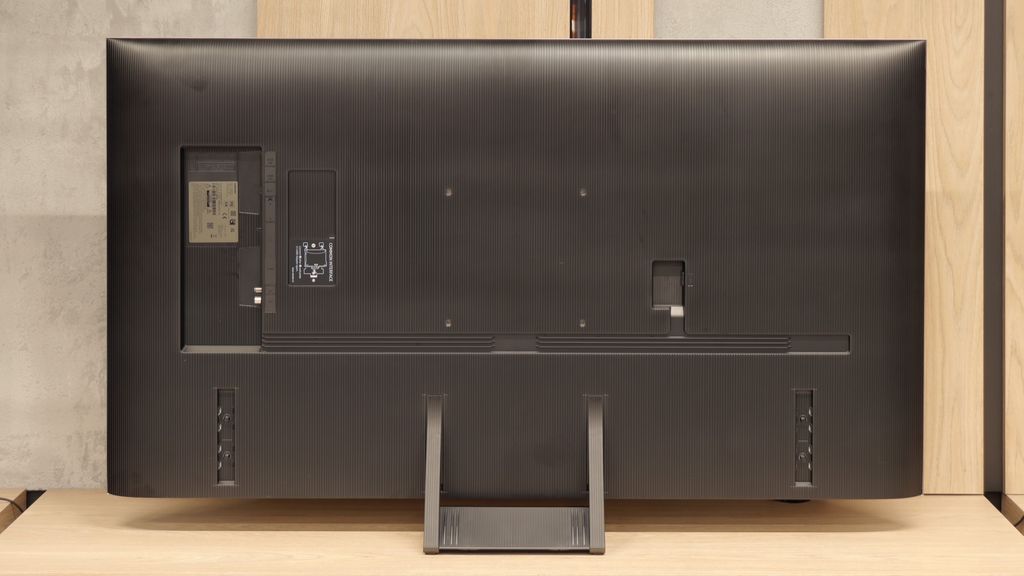
Contrast and black detail
6/10
7.5/10
Local dimming function: No
Local dimming function: Yes, number of zones: 240 (20 x 12)
Contrast:

Result
4,800:1

Result
4,750:1

Result
14,900:1

Result
4,500:1

Result
4,300:1

Result
101,800:1

Result
18,650:1

Result
47,050:1

Result
9,700:1

Result
4,350:1
Halo effect and black detail visibility:

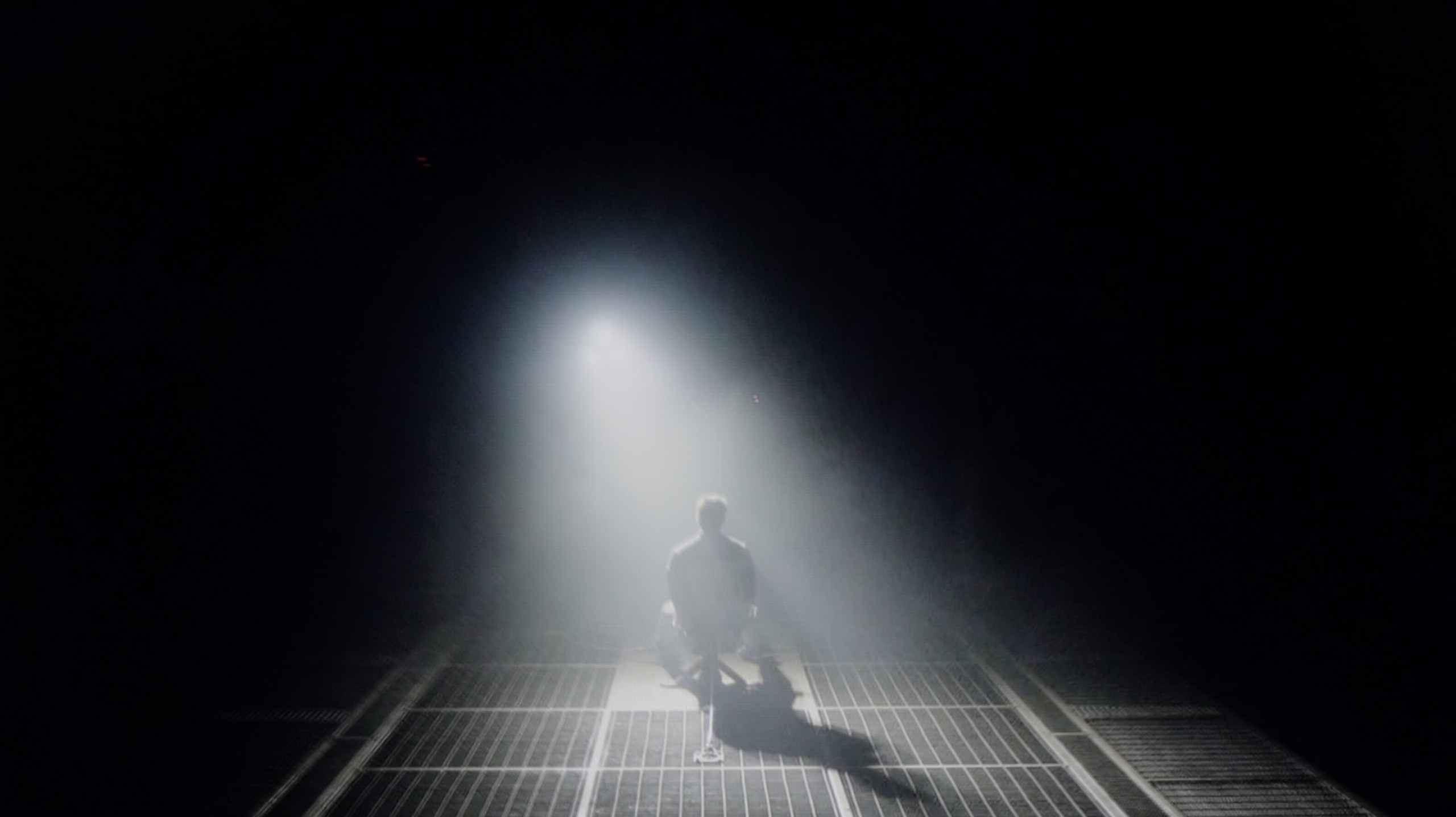
The year 2025 looks quite interesting when it comes to lifestyle TVs. Why? Because Samsung has prepared two versions of the iconic model The Frame – one regular and another with the "Pro" label. In this review, we take a look at the version without "Pro," which – as will soon become evident – is quite significant. The regular model LS03F does not feature any local dimming technology, unlike its more expensive sibling. This is important because it affects not only the overall picture quality but primarily how this TV handles black levels.
The VA panel used in The Frame 2025 has a high native contrast – and this obviously works to its advantage. In the tested movie scenes, details in the dark parts of the image were clearly visible; nothing blended together, and it didn’t create a uniform black/bright spot. For the average viewer, this will be more than sufficient. But of course, not everything is perfect. The lack of local dimming causes the black levels on this TV not to be perfectly deep – it resembles a dark navy more than pitch black. Additionally, in our tested unit, we noticed slight backlighting in the right part of the screen, but this may just be the "beauty of the specimen" rather than a rule. Theoretically, one could try to improve the perception of blacks by backlighting the screen – for example, with an LED strip – but in the case of The Frame, this is rather impossible because this TV is meant to sit flush against the wall like a painting. So to achieve better blacks visible to our eyes, we are forced to watch the LS03F with the lights on. Such is the charm of this technology.
Our editorial team received a 55-inch model with a VA panel. In the case of NeoQLEDs, which are TVs with Mini-LED backlighting, size is incredibly important because the larger the screen, the more local dimming zones it can have. This directly translates to higher contrast. In the variant we tested, we counted as many as 240 dimming zones, which is twice as many as in last year's QN85D. Theoretically, such an increase should bring an equally impressive improvement in contrast. Unfortunately, practice showed something different – the QN85F offers results very similar to its predecessor. Yes, in some scenes with a lot of black or in areas where details in the highlights are crucial, there is progress, but it is not proportional to the number of zones. Mini-LED technology can be capricious, and sometimes around small, bright objects, there are subtle halos. This is a typical compromise that one must accept with such a solution. Nevertheless, the contrast in the QN85F is at a very high level and will easily satisfy most users, even the more demanding ones. However, we have the impression that Samsung could refine the algorithms controlling dimming because we know from experience that they can perform really well in other models.
HDR effect quality
6/10
6.9/10
Luminance measurements in HDR:

Result
642 nit

Result
589 nit

Result
574 nit

Result
584 nit

Result
631 nit

Result
1248 nit

Result
860 nit

Result
1093 nit

Result
465 nit

Result
957 nit
Scene from the movie “Pan” (about 2800 nits)


Scene from the movie “Billy Lynn” (about 1100 nits)


Static HDR10


Dynamic: HDR10+
Dynamic: HDR10+


HDR luminance chart:
Samsung QN85F
HDR luminance
Samsung The Frame 2025 (LS03F)
HDR luminance
The Frame LS03F is a television that can surprise with its brightness. The maximum luminance reaches around 650 nits, which already looks solid on paper. But as we know, lab tests are one thing, and real movie scenes tell a completely different story. When watching HDR content in natural conditions, The Frame 2025 maintains very good results. In most film scenes, peak brightness remained at levels of 550–650 nits. This is enough to feel the difference between standard image quality and that of HDR – bright highlights, reflections on water, and moonlight appear clear and impressive.
It’s also worth noting that the LS03F is a QLED television, which translates to solid color saturation. The coverage of the DCI-P3 color space reaches about 92%, allowing for vibrant, intense colors in HDR content. It may not be at the level of top premium models, but for a lifestyle screen, the result truly deserves recognition.
Although the more than double number of dimming zones compared to its predecessor has not translated into a spectacular jump in black levels and contrast, we definitely felt it in the HDR effect itself. The QN85F is up to 50% brighter than last year's model, making a huge impression in dynamic scenes. The peak brightness can reach nearly 1700–1800 nits, which is truly impressive in this Mini-LED class. The best part is that almost regardless of the scene being viewed, the HDR effect remains strong and vibrant. In four out of five test scenes, the brightness was around 1000 nits, a level that in most cases allows viewers to feel the true magic of this format. Of course, in scene number 4 from the movie Sicario 2, the limitations of Mini-LED technology become apparent – the brightness of the helicopter's spotlight drops to around 500 nits. It's not an outstanding result, but it's still much more acceptable than in last year's model. Samsung deserves applause, as the improvement in brightness in the QN85F is substantial compared to its predecessor. However, it's a pity about a certain trend seen in this year’s televisions – the manufacturer has worsened the color gamut coverage. Although the QN85F has a QLED panel, its result of around 90% DCI-P3 is average, and in the most demanding films, it can lead to less vibrant colors than in the predecessor. Despite this shortcoming, the overall HDR effect is at an excellent level and really makes a big impression in this class of devices.
Factory color reproduction
7.1/10
4.8/10


Factory Mode
After calibration


Factory Mode
After calibration
When it comes to image quality right out of the box, even in Filmmaker mode, which is supposed to be the closest to reference, there were issues. In both HD and 4K HDR content, we noticed noticeable deviations in white balance. The image was heavily skewed towards red and blue, giving the screen a characteristic rosy tint. This effect was most visible in bright scenes – for example, in shots with a lot of white, where neutral light should naturally dominate. In such moments, the screen clearly leaned towards pink tones, which can also be seen in the attached comparison photo. As for brightness characteristics – it wasn't as bad as one might expect given such color inaccuracies. Analysis of the gamma curve and EOTF showed a slight brightening of the image compared to the reference, but not enough to drastically affect the perception of the material.
The Samsung QN85F offers several preset picture modes, but out of the box, the television starts in "Eco" mode. We could actually end the discussion here, because for such a model, using this setting makes no sense – the picture is washed out, unpleasant, and far from what we expect from a television of this class. Therefore, we conducted our tests in the best available mode, which is the Filmmaker mode. Its purpose is to faithfully reproduce what the directors saw while filming, and indeed, this setting performs best among all the factory options. However, this does not mean it is free of flaws.
Both in SDR and HDR, the QN85F strongly highlighted warm colors. This stemmed from a lack of white balance, with a noticeable absence of blue. Additionally, the picture sometimes appeared overexposed – both the gamma brightness characteristic and the EOTF curve indicated that the television has a tendency to blow out scenes. In SDR, the color reproduction errors (Delta E at levels of 4–5) were still acceptable, but in HDR, the inaccuracies became really significant and clearly deviated from what the creators intended to show us. Fortunately, Samsung provides a wide range of calibration tools in its televisions, so – as always – we proceeded with professional calibration to see how much could be improved.
Color reproduction after calibration
8/10
8.5/10




After calibration, the movie mode gained a completely new quality. The issue of pink tint, which had previously been clearly visible, especially in bright scenes, was effectively eliminated. Colors began to look much more natural, and the white balance no longer dominated the rest of the image. It was no longer the same exaggerated “box picture” – everything gained coherence and a cinematic character. Additionally, the tendency of the television to slightly brighten scenes, previously visible in the EOTF curve analysis, was partially corrected. Of course, this was within the limits of what the design allows without local dimming – it’s hard to speak of perfect brightness management here. Nevertheless, the final effect was definitely closer to what one would expect from a mode called Filmmaker.
After calibrating the movie mode, we managed to tame the colors in both modes to nearly perfection – most of them did not exceed an error value of 3, which is the limit of visibility to the human eye. The image became more natural, fuller, and at the same time devoid of the blooming that was noticeable right after taking the TV out of the box. This shows how much potential lies in the QN85F and how well it responds to precise settings. However, this does not change the fact that certain technological barriers cannot be overcome. Despite the significant benefits of calibration, limitations of the panel itself still remain. Although the number of dimming zones has doubled compared to its predecessor, the algorithms controlling the backlighting can manipulate brightness in their own way. Sometimes this leads to slight color distortions or subtly visible halo effects around bright objects. Nonetheless, the reception after calibration is really pleasant and shows how good a screen the QN85F can be if we just take a moment for the right settings.
Smoothness of tonal transitions
9/10
9/10

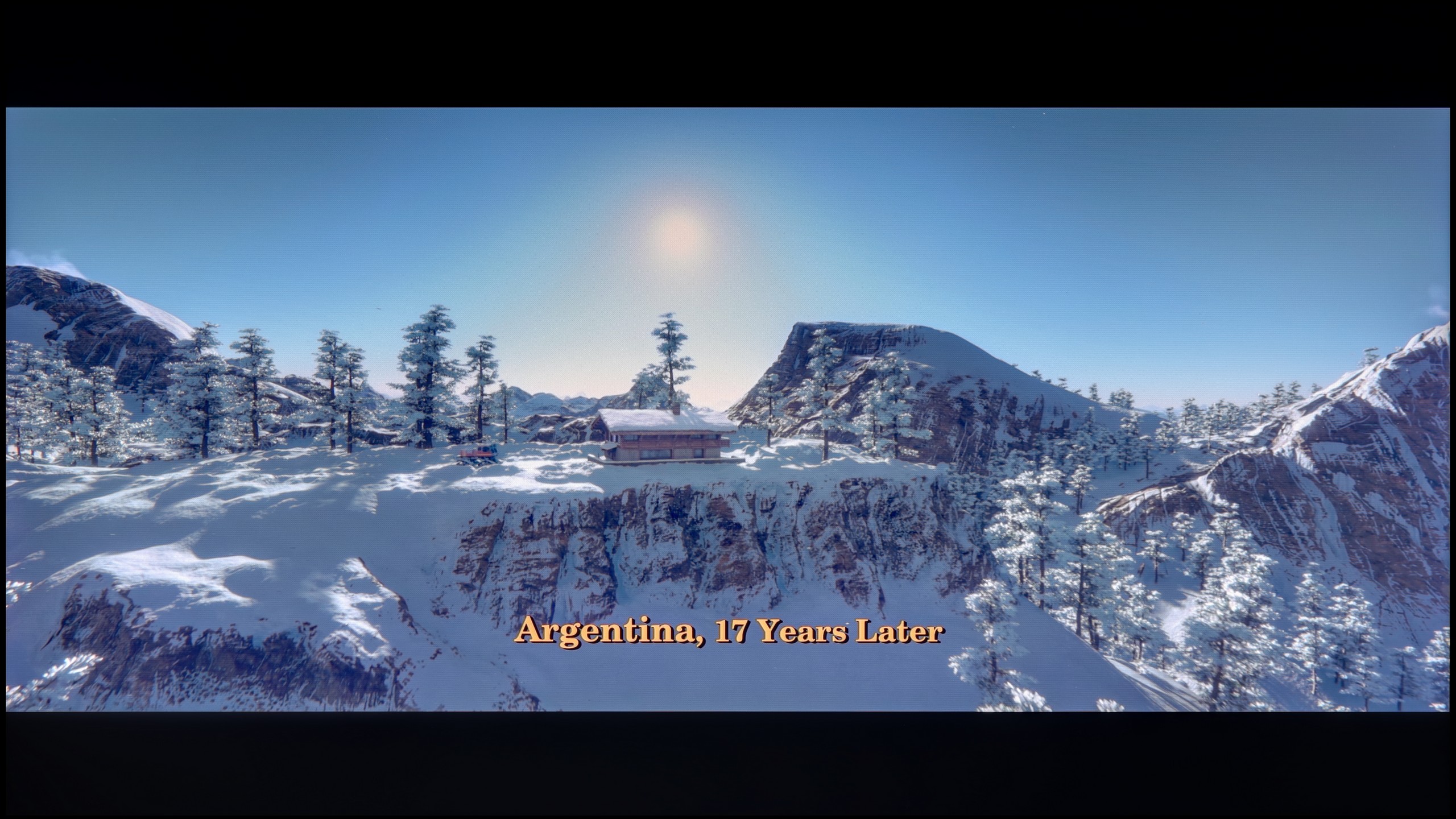










In terms of the fluidity of tonal transitions, the LS03F maintains a high level – just like last year’s models. The television had no issues during the testing of more challenging movie scenes, where visible transitions between color shades can easily occur. The color grading is very good here – both in the lighter and darker parts of the image. We did not observe the typical banding effect or other disturbances that could stand out while watching movies. If we had to nitpick, in the most demanding scenes – with subtle transitions and delicate gradients – small imperfections can be noticed. But only when one gets really close to the screen and begins to analyze the image from a distance not intended by the manufacturer.
Minor color errors are practically unnoticeable; it is the smoothness of tonal transitions that is a category that even a less experienced viewer will notice. Unfortunate bands and artificial lines can completely ruin the perception of the image. Fortunately, the QN85F handles this aspect almost perfectly. Gradients are smooth, transitions between colors are seamless, and there are no artificial strokes or clear lines separating the hues on the screen. The image remains cohesive, and nothing distracts our attention from the content. Only under very extreme conditions did we notice slight issues in the gray palette, but this is a drawback typical of most televisions and it's hard to consider it a serious downside. In practice, while watching movies, we encountered no problems.
Image scaling and smoothness of tonal transitions
6.7/10
7.5/10
Smooth transition function

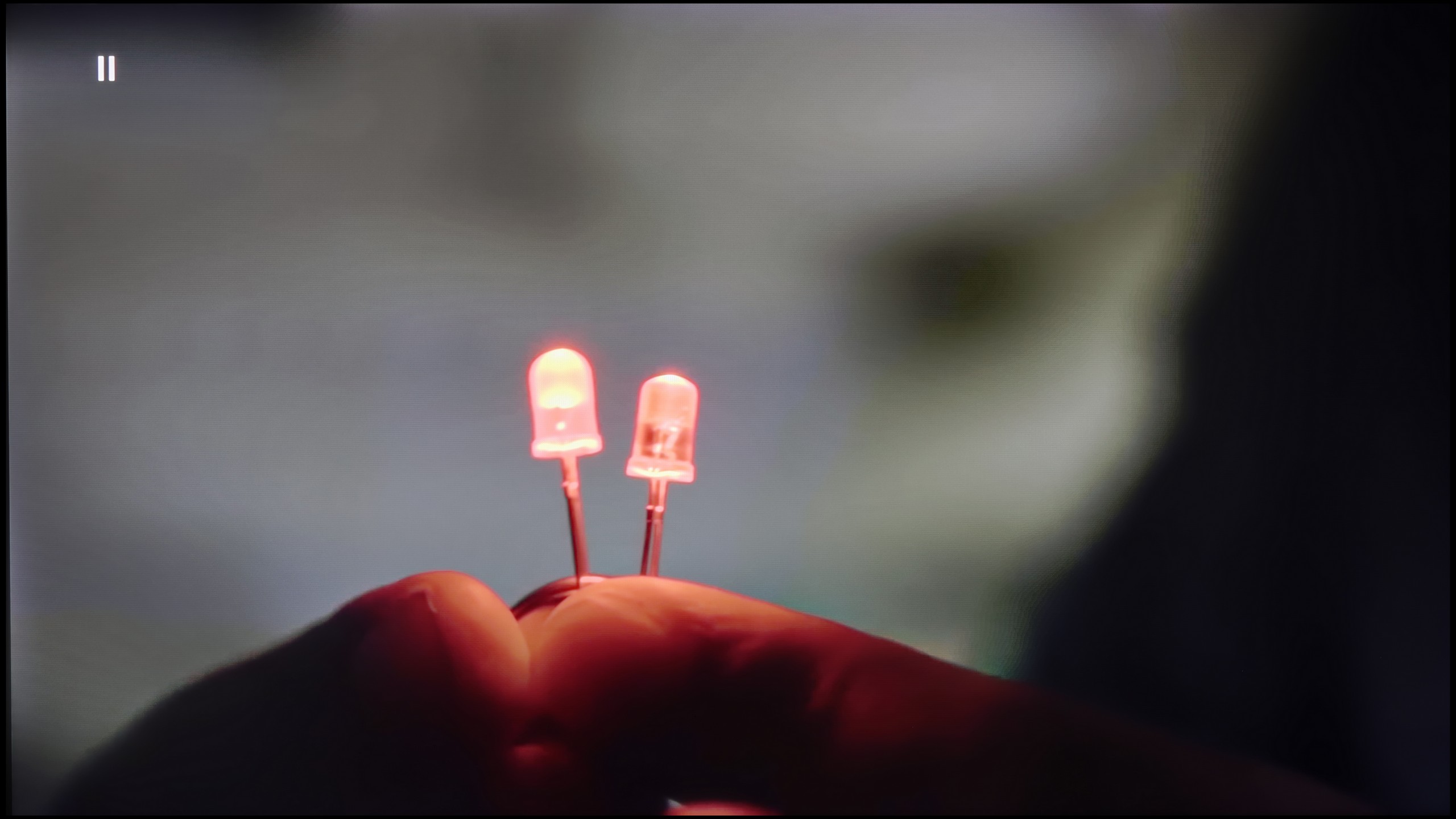
Image without overscan on the SD signal


The LS03F is equipped with the NQ4 processor, which is responsible for improving image quality—especially in lower-quality materials. In practice, it works surprisingly well, particularly with older content and recordings with lower resolution. Activating the "noise reduction" feature yields noticeable effects. The television effectively smooths tonal transitions and removes digital noise that can appear in darker areas of the image. Compared to previous generations, there is a clear improvement—previously, this feature often smoothed everything too much, including details that it shouldn't have removed. In this year's model, the smoothing still occurs, but it is done in a much more acceptable manner. Textures of materials, skin, or fabric details are no longer so heavily muted as before—the image retains more naturalness. However, this does not change the fact that film grain is still removed by the television, which may not be to everyone's liking. On the other hand, it is no longer as aggressive an intervention as in previous models. It is also worth mentioning that the LS03F may struggle with very weak signals—such as recordings from VHS tapes or video in low resolution. In such cases, we noticed slight clipping of the image at the edges—so-called overscan. This can lead to situations where a small part of the image (e.g., subtitles at the bottom edge) gets cut off.
Although the native tonal transitions on the QN85F perform excellently with 4K materials, we don't always deal with content in the highest resolution. That's when it becomes crucial how the television handles upscaling and digital image processing. This process is managed by Samsung's proprietary processor – AI NQ4 Gen2. In practice, it works very efficiently. If visible color banding or other undesirable phenomena appear on the screen, for example in materials from YouTube, they can be easily smoothed out using the "noise reduction" function. Set to medium, it improves tonal transitions while not excessively blurring desired details. However, it's important to remember that – as with most Samsung televisions – this feature significantly affects the film grain. Therefore, during movie screenings, it's advisable to use it cautiously to maintain the natural character of the image.
The upscaling itself looks very good. Test materials in lower resolutions were displayed sharply and clearly, with a lot of detail. The only drawback remains the issue of overscan, which is cutting off the edges of the screen. In most situations, this is not noticeable, but with very old materials below HD quality, there may be instances where part of the image on the left side is slightly cropped.
Blur and motion smoothness
6.9/10
7.7/10

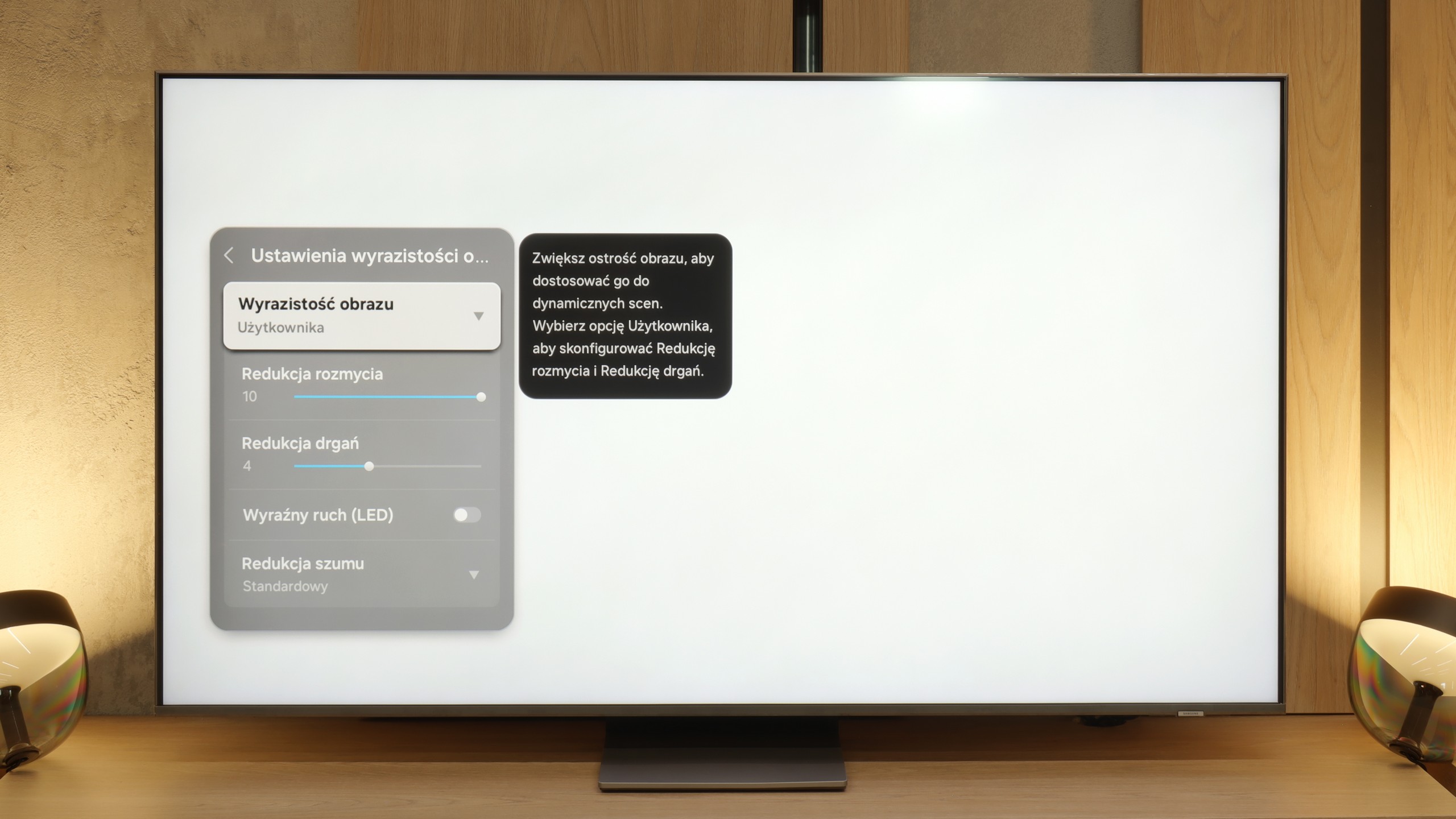
Blur (native resolution, maximum refresh rate):




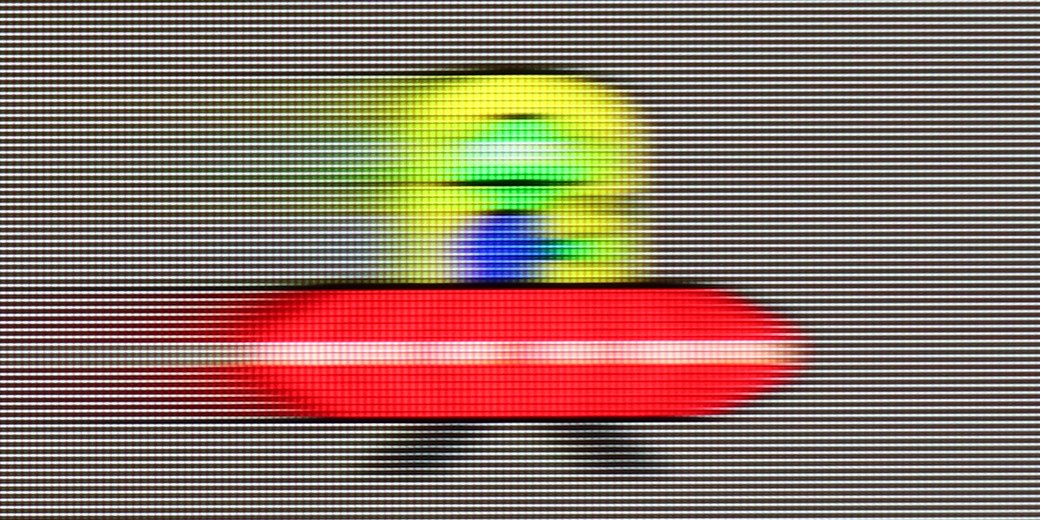
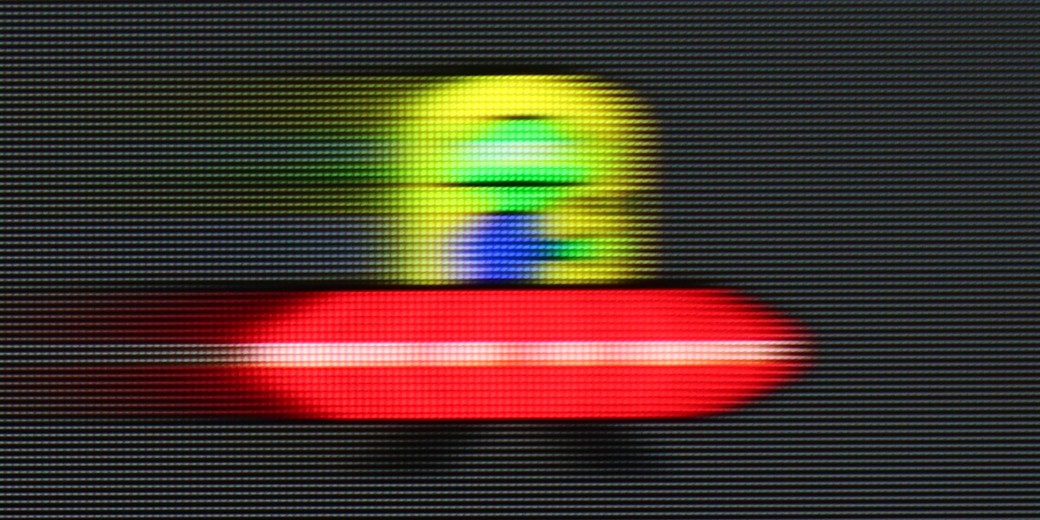
Blur (BFI function enabled):
Image flickers in this mode



Image flickers in this mode



Smużenie ():
Smużenie (4K@144Hz):

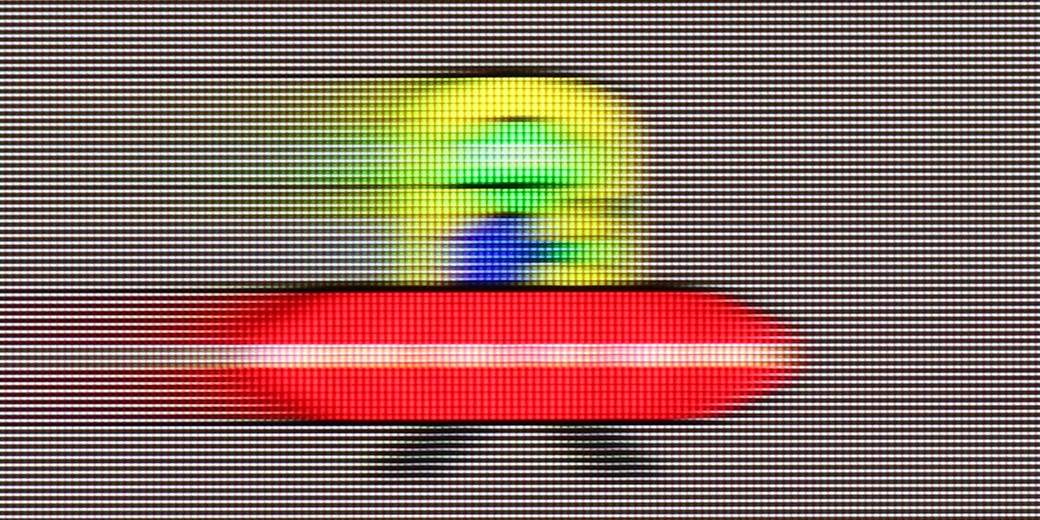
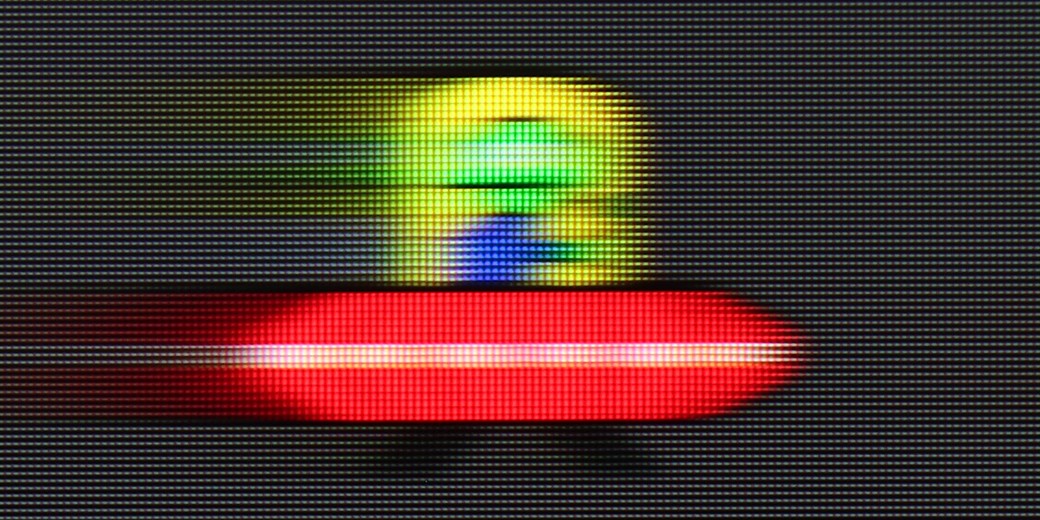
A novelty in The Frame for 2025 is the panel with a refresh rate of 144 Hz. Yes – in a television primarily associated with displaying artwork, you can now not only watch Van Gogh but also comfortably play on a console or follow dynamic sports action. This is a definite step towards greater versatility. In the case of Samsung films, as usual in models with a 120 Hz panel and above, it allows you to adjust motion smoothness according to your own preferences. You can set a more cinematic representation while maintaining frame rate or opt for full motion smoothing. The range of options is wide, allowing you to tailor the effect to your taste – whether the viewing experience is meant to resemble classic cinema or a presentation on a modern theater panel.
*this part of the test refers to the model LS03FAU in sizes 55 and 65 inches, which is equipped with a 144Hz panel; the 43 and 50-inch sizes have 60Hz panels, and therefore perform much worse in terms of motion smoothness.
Motion blur and fluidity of motion in the QN85F is a topic worth discussing in more detail, as the television is equipped not with a standard 120 Hz panel, but with a 144 Hz panel. The additional hertz will primarily be appreciated by PC gamers, but the mere presence of such an option can be seen as a nice addition and a sign of the times – it’s hard to complain about the trend towards faster panels, since in practice, each of us would like the image to be as fluid as possible. However, the most important thing is how the television handles typical 120 Hz refresh rates – in the case of consoles, sports, or films recorded at 24 or 30 frames per second. And here, the QN85F performs really well. In movies, you can easily adjust the character of the image thanks to the “picture clarity” function, where we find two adjustable sliders. Key for viewing sessions is the one responsible for reducing motion blur. Lower values give the image a more cinematic character with preserved “frame rate,” while higher values lead to a strong smoothing that resembles television theater.
Console compatibility and gaming features
8.2/10
8.2/10
- ALLM
- VRR
- VRR range48 - 144Hz48 - 144Hz
- Dolby Vision Game Mode
- Correct implementation of HGIG
- 1080p@120Hz
- 1440p@120Hz
- 4K@120Hz
- Game bar

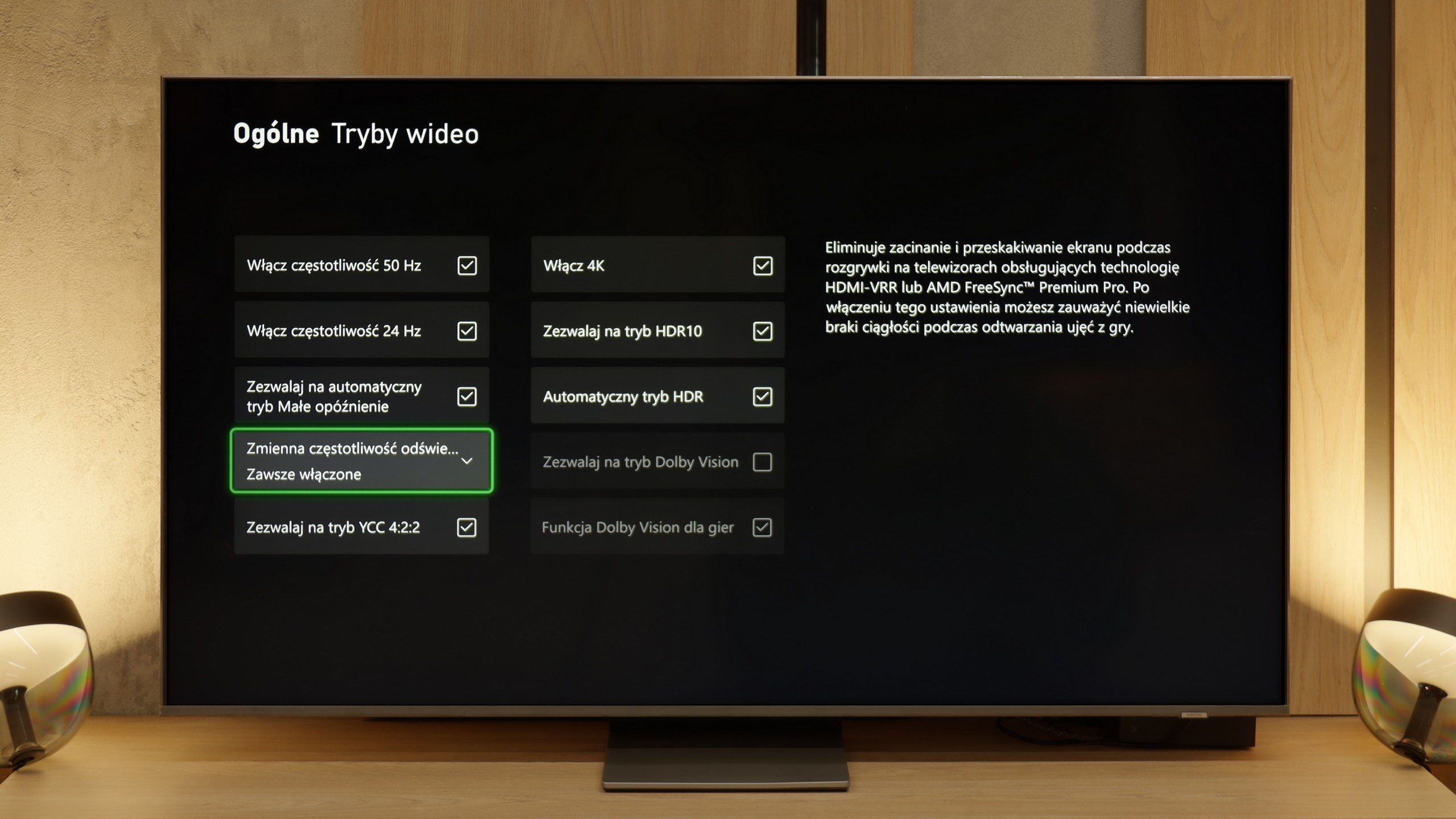

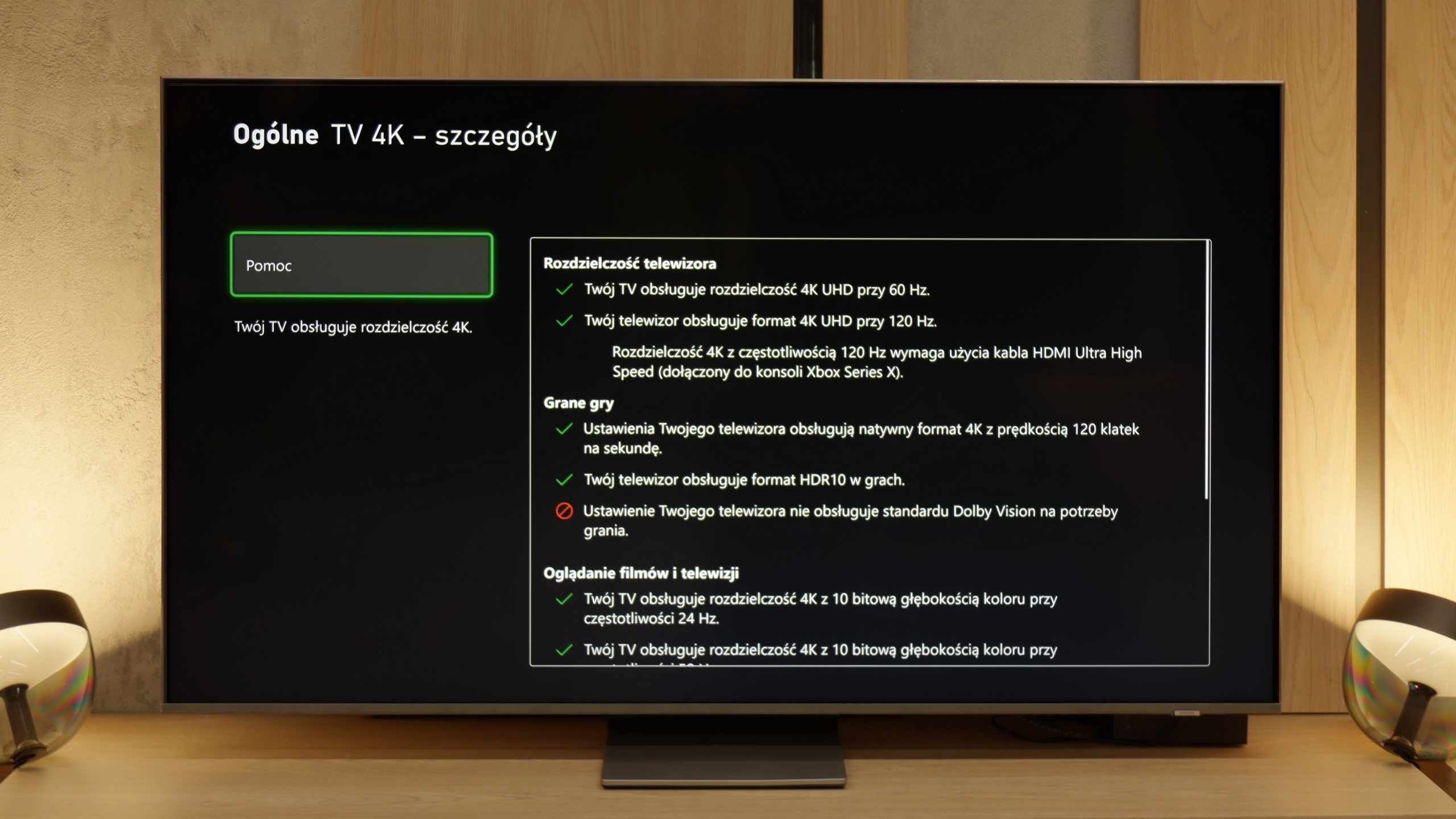

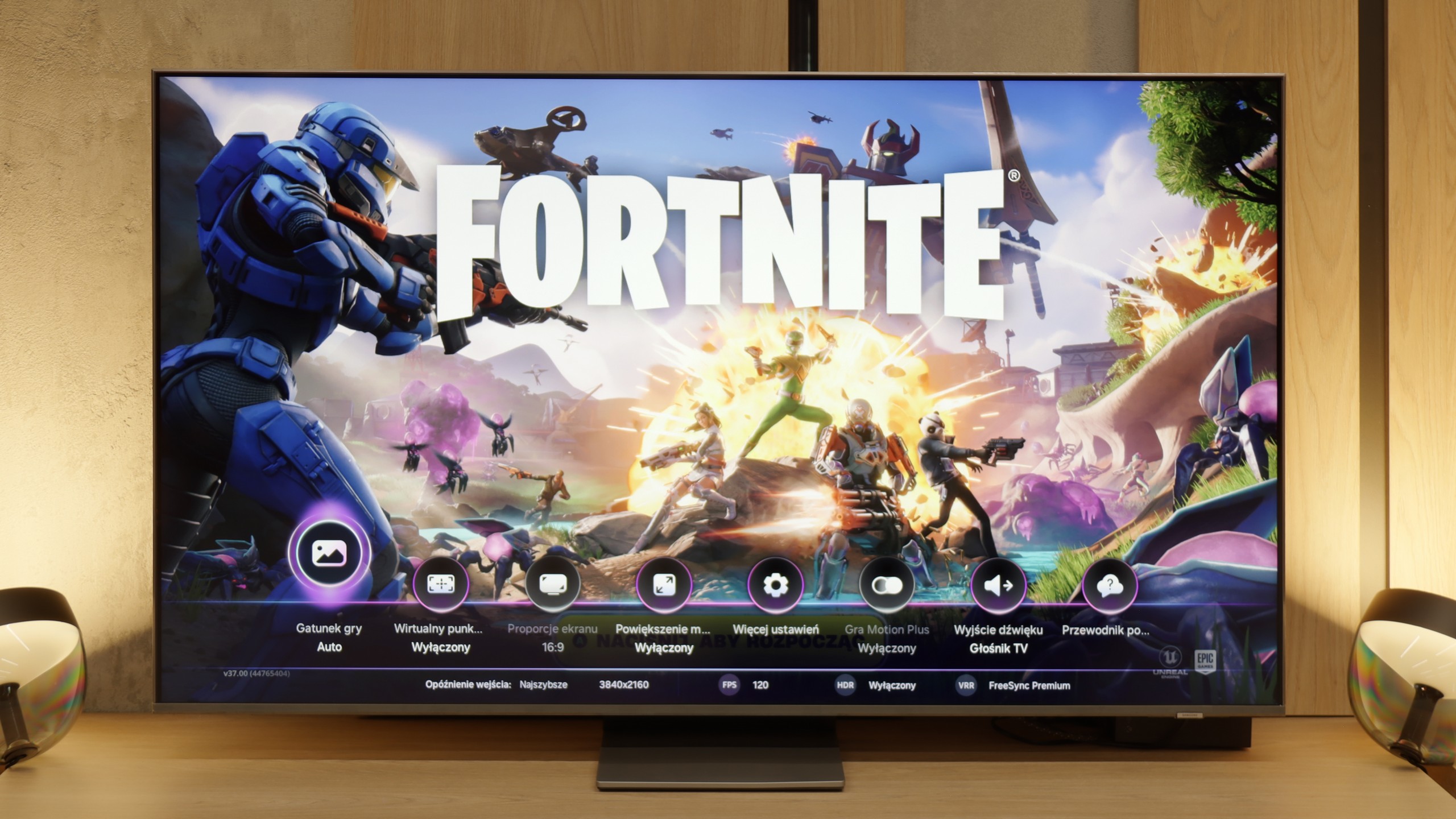

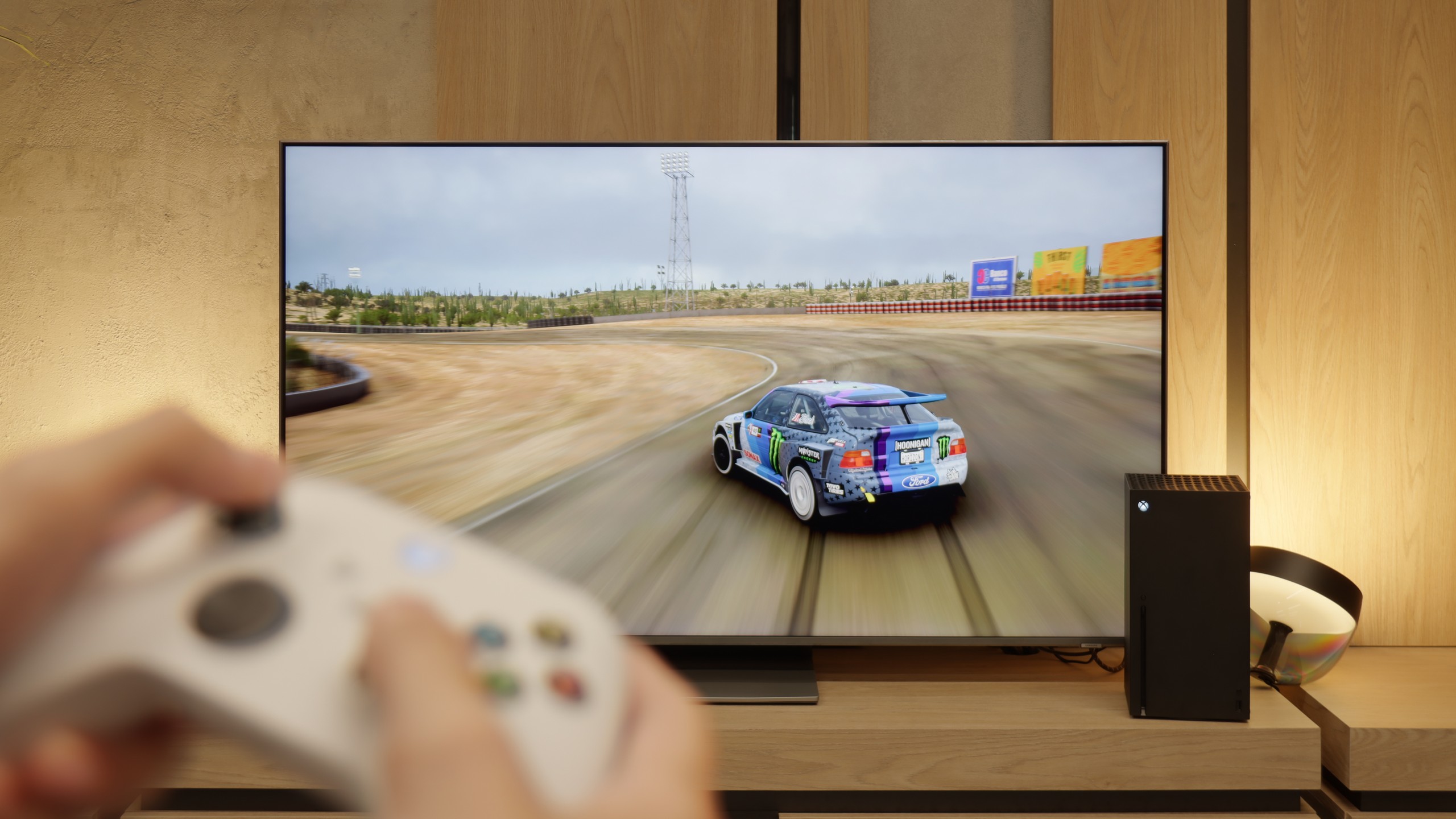
As we mentioned earlier – although The Frame likely displays images and works of art most of the time, Samsung has recognized that a Van Gogh enthusiast can just as easily be an avid gamer. And it must be admitted that The Frame 2025 has almost everything it needs to become a fully-fledged gaming television.
On board, we find support for ALLM (automatic game mode) and variable refresh rate (VRR) thanks to the implementation of one HDMI 2.1 port. The television handles lower resolutions at higher refresh rates without any issues and features an expanded Game Bar – already known from other Samsung models – which allows for quick previewing and changing of the most important gaming-related settings. For this, it earns additional points from us. The proprietary motion smoother Auto Motion Plus Game also deserves special mention, which – and it's worth emphasizing – works without increasing input lag. Samsung remains the only manufacturer that has managed to implement this feature in a practically noticeable way in terms of delays. The result? Much better fluidity in games, especially those that struggle to maintain stable 60 frames. This solution can realistically improve the gaming experience in more demanding titles – especially on consoles that don’t always manage full fluidity, especially in AAA games.
As for the downsides – the lack of Dolby Vision is already considered standard in Samsung televisions, so there's nothing to particularly complain about here. However, the problem is something entirely different. In the latest version of the Tizen system, the HGiG option has disappeared. Literally – it's not there. This is a significant setback when configuring a console for proper HDR content display in games. It’s hard to understand why such a decision was made, but one thing is certain – this should be fixed as soon as possible. We are talking about a brand that has set standards for gaming on televisions for years. If HGiG comes back – and we hope that it will – The Frame LS03F can confidently aspire to be a true gaming television. Not just as a decoration on the wall, but as equipment that really provides joy in gaming.
The Samsung QN85F makes a really great impression from a gaming feature standpoint. We have four HDMI 2.1 ports here, so we can connect multiple devices simultaneously without any problems. It also has variable refresh rate (VRR), which prevents screen tearing, as well as automatic game mode (ALLM), which allows the TV to switch to the appropriate settings by itself when we launch the console. Additionally, it supports refresh rates of up to 144 Hz – something that PC gamers will particularly appreciate, but the fact that such an option is available shows that Samsung is fully committed to supporting gamers. The Game Bar panel also deserves praise. It provides a quick overview of the most important parameters – from frame rates, to refresh modes, and even shortcuts to picture settings. Instead of digging through the entire menu, we have everything at our fingertips, which turns out to be really convenient in practice. However, the most interesting addition is the Game Motion Plus feature. It’s essentially a motion smoother, adapted for the gaming world. When enabled, the image becomes smoother; sometimes it even looks as though we’re getting a few more frames, and importantly – the response delay doesn’t increase enough to hinder gameplay. This is a solution that truly distinguishes Samsung’s 120Hz TVs from the competition.
The only serious drawback remains the lack of proper HGiG support. This is the standard that ensures correct tone mapping in HDR games, meaning that brightness and contrast are displayed according to how the developers intended them. Without HGiG, we have to manually adjust the brightness, which doesn’t always result in an ideal outcome. The feature was available in previous models, but it disappeared in the QN85F after one of the updates. We hope that Samsung will quickly fix this issue, and we will be keeping an eye out to see if they succeed.
Input lag
10/10
9.8/10
SDR
HDR
Dolby Vision
In terms of input lag, Samsung maintains a high standard – and it's a very high one. The LS03F, like most of this year's models from this brand, achieves a score of 8 ms for 4K content, which is almost a reference value. This result allows you to play even the most dynamic titles without delays and with full responsiveness. Well done!
The input lag on the QN85F is at a very high level. With content at 120 or 144 Hz, the values often oscillated below 10 ms, which is an absolutely remarkable result. Naturally, when playing at 60 Hz, the lag doubles, but it still remains low enough that in practice it is virtually unnoticeable. Thanks to this, the QN85F will be suitable for both dynamic e-sports games and calmer console titles.
Compatibility with PC
8.2/10
8.4/10

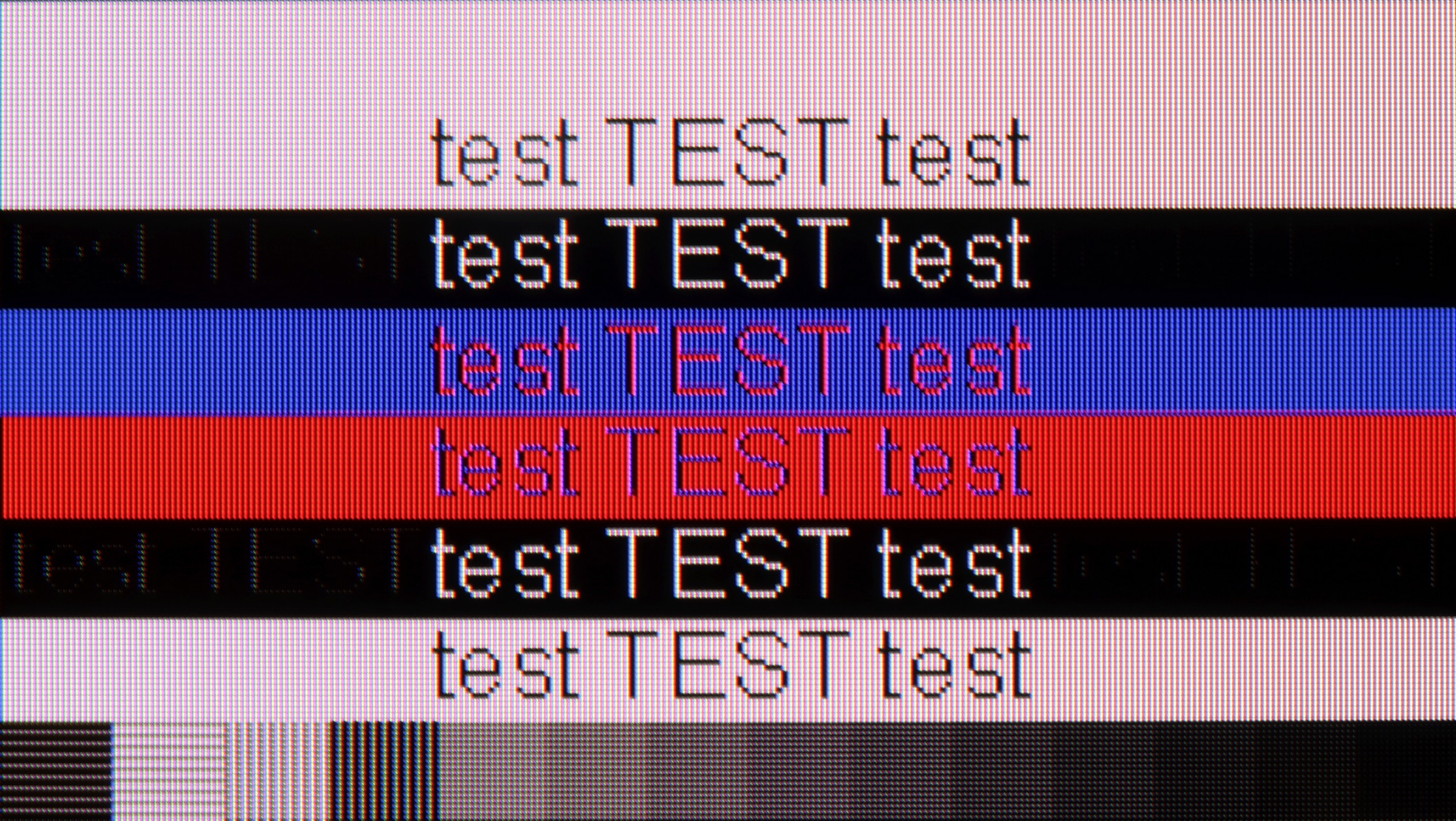
The collaboration of The Frame 2025 with a computer poses no major issues. Let's start with gaming, as this is where this model shows its strengths – support for a 144 Hz signal, low input lag, and compatibility with G-Sync technology (for NVIDIA cards) make it hard not to consider it a fully-fledged gaming monitor. It is one of the more interesting "PC gaming" TVs available on the market in this class.
When it comes to daily work, the situation looks just as good. The Frame easily handles chroma 4:4:4, which translates to good font readability and overall user comfort. We only noticed minor issues with dimming very thin lines and dark details on a bright background – this effect may occur particularly when working with small interface elements. However, in practice, with a 55-inch screen and standard office working distance, it will be difficult to notice this problem realistically. Nonetheless, it's worth keeping this in mind if the television is to serve as a monitor not only for entertainment but also for precise work with graphics or text.
The QN85F performs really well in terms of cooperation with a computer. Thanks to the PC mode with a refresh rate of up to 144 Hz, support for G-Sync, and low input lag, gaming on a personal computer is very enjoyable and should not cause irritation even for more demanding players. The readability of fonts also looks good – the television supports chroma 4:4:4, so standard texts appear sharp and clear. A problem arises only with very thin letters. Regardless of the refresh rate setting – whether it’s 144, 120, or 60 Hz – horizontal, thin lines were hardly visible. Reducing the refresh rate slightly improved the situation, but never enough to say that they were displayed perfectly.
Viewing angles
3.5/10
3.2/10
As one could expect from a VA panel, the viewing angles on The Frame 2025 are at best average. The image loses saturation and contrast when viewed off-angle. It’s a pity, because we are talking about a model that displays digital artworks while in standby mode—and it is precisely in such moments that wide viewing angles would make the most sense, enhancing the feeling of being in the presence of a real image, rather than just its screen imitation.
Perhaps in the future, manufacturers will decide to introduce special coatings or modified versions of VA panels that will improve this aspect—because in the case of lifestyle televisions, it would have real significance not only in terms of usability but also aesthetics.
The viewing angles on the QN85F are a classic Achilles' heel of most LCD TVs with VA panels. When looking at the screen at an angle, there is a noticeable drop in brightness fairly quickly, and whites begin to gray out while colors lose their intensity. This is the price to pay for the high contrast that this technology offers. Samsung could have aimed for a better coating to widen the viewing angles in this model, but it is not found here. In practice, this means that the best viewing experience will be achieved when sitting directly in front of the TV, and any significant deviation will result in a clear loss of image quality.
TV efficiency during daytime
6.3/10
6.9/10

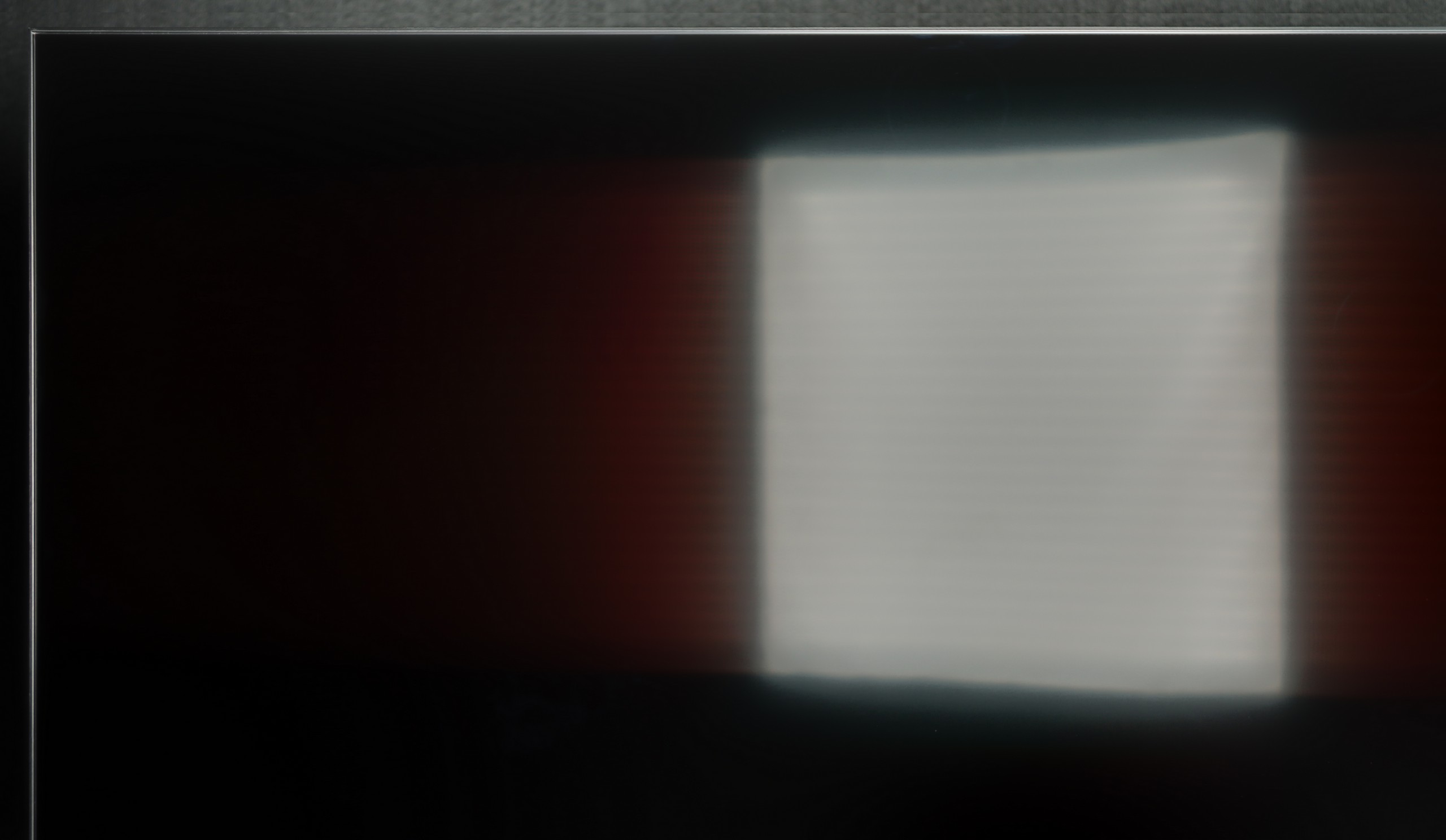


Matrix brightness
Average luminance SDR
Samsung QN85F : 690 cd/m2
Samsung The Frame 2025 (LS03F): 596 cd/m2
One of the most characteristic features of The Frame is its matte display – and it must be admitted that Samsung has really refined this aspect. From our experience, this is one of the best solutions for reducing reflections, especially direct ones. If reflections on the screen can be irritating, it will be hard to find a better display in this budget than the matte panel used in Samsung TVs. Of course, this comes with a certain compromise. In very strong sunlight, colors may appear slightly washed out, and the image loses some depth. However, this is something we consciously accept when choosing a matte screen – something for something. In practice, the colors and contrast on Samsung's matte screen still perform better than on Chinese models like TCL NXT Vision or Hisense Canvas TV. If effectively reducing reflections and the desire to use the TV also as a 'digital picture' in bright rooms are priorities, it’s hard to find a better choice.
The Frame achieves about 600 nits of brightness, which, combined with the matte coating, allows the TV to handle well-lit daytime conditions without any issues. It may not reach the level of flagship models, but in everyday use – in a living room with plenty of light – it performs seamlessly.
QN85F performs excellently during the day. The satin coating of the panel combined with high brightness makes it a television designed for bright rooms. Colors do not lose their intensity, and the image does not wash out even when a lot of light comes in. The television itself is bright enough to handle a living room with large south-facing windows without any problems. Thus, the QN85F provides an image that allows us to watch movies or games during the day without annoying reflections and the feeling that the picture is fading in the sunlight.
Details about the matrix
Subpixel Structure:

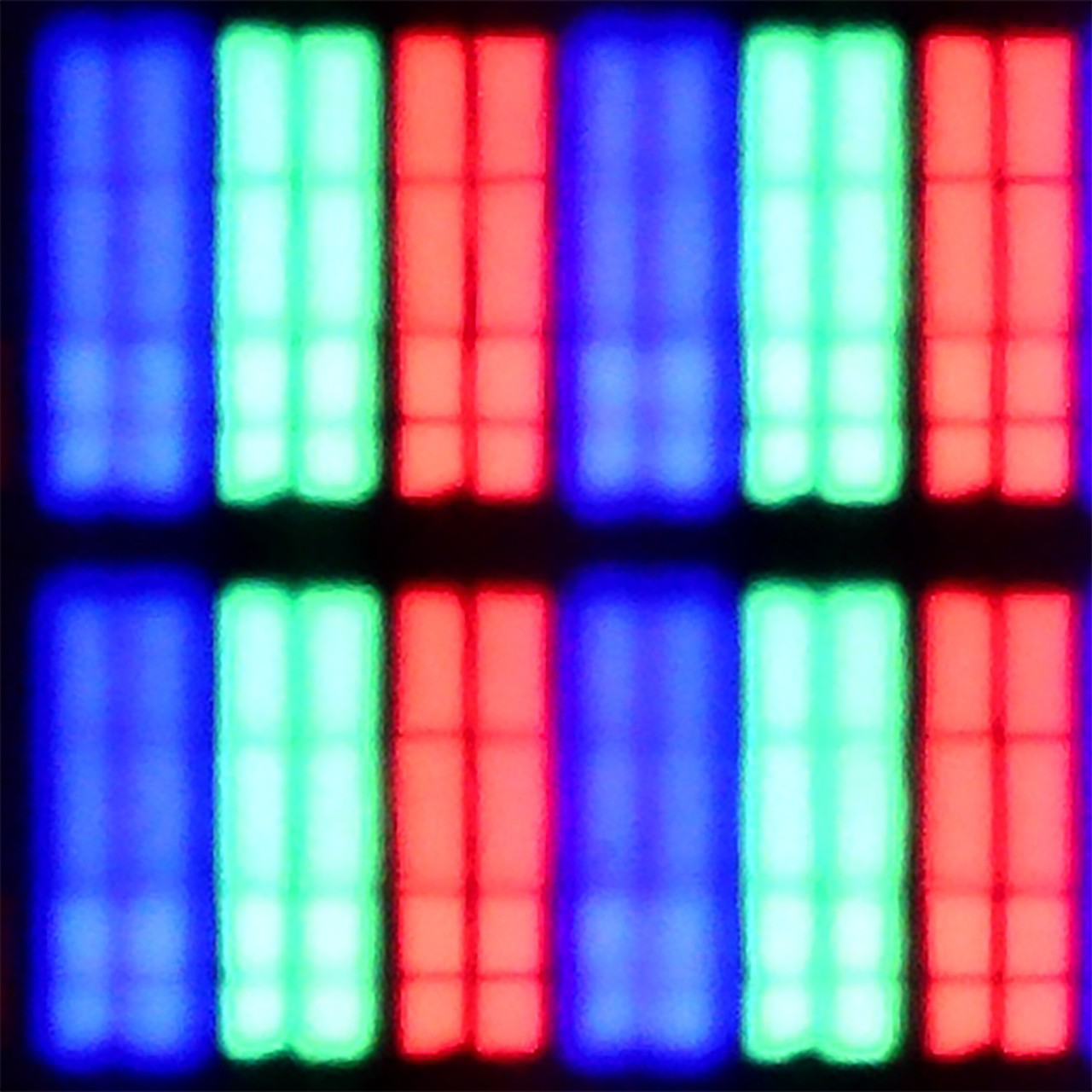
Panel uniformity and thermal imaging:


Samsung The Frame 2025 (LS03F)
Samsung QN85F
TV features
7.2/10
7.3/10
- HDMI inputs3 x HDMI 2.0, 1 x HDMI 2.1 40Gbps0 x HDMI 2.0, 4 x HDMI 2.1 48Gbps
- OutputsToslink (Optical audio), eARC (HDMI), ARC (HDMI)Toslink (Optical audio), eARC (HDMI), ARC (HDMI)
- Network InterfacesWi-Fi 2.4GHz, Wi-Fi 5GHzWi-Fi 2.4GHz, Wi-Fi 5GHz, Ethernet (LAN) 100Mbps
- TV receptionDVB-T, DVB-T2, DVB-S, DVB-S2, DVB-CDVB-T, DVB-T2, DVB-S, DVB-S2, DVB-C
Classic features:
- Recording to USB (terrestrial TV)
- Recording programming
- Picture in Picture (PiP)
- RF remote control (no need to aim at the screen)
- Backlit remote control
- Teletext
- Audio only mode
- Bluetooth headphones support
- Simultaneous Bluetooth headphones & TV audio
Smart features:
- AirPlay
- Screen mirroring (Windows Miracast)
- Voice search
- Voice search in native language
- Ability to connect a keyboard and mouse



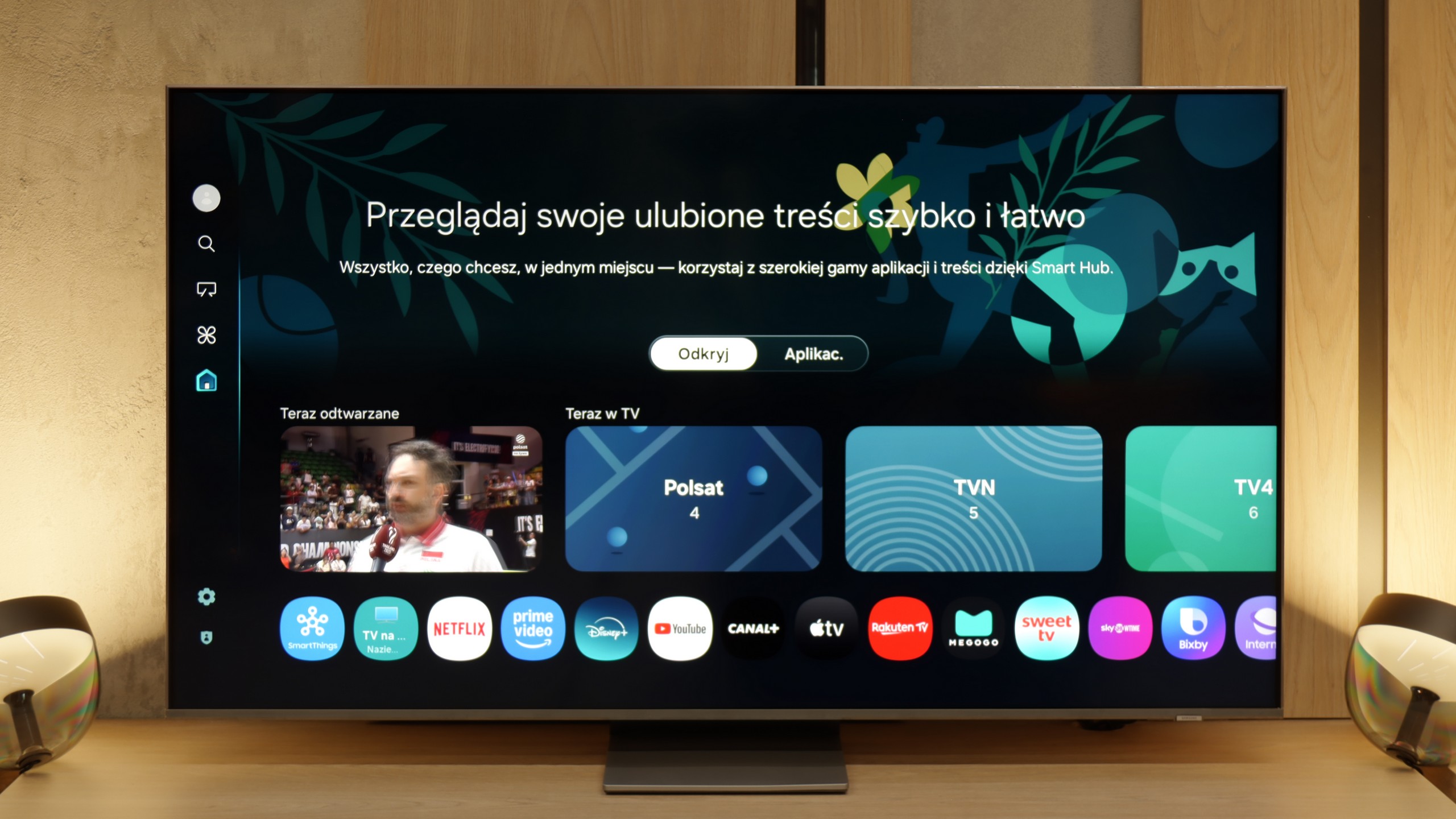
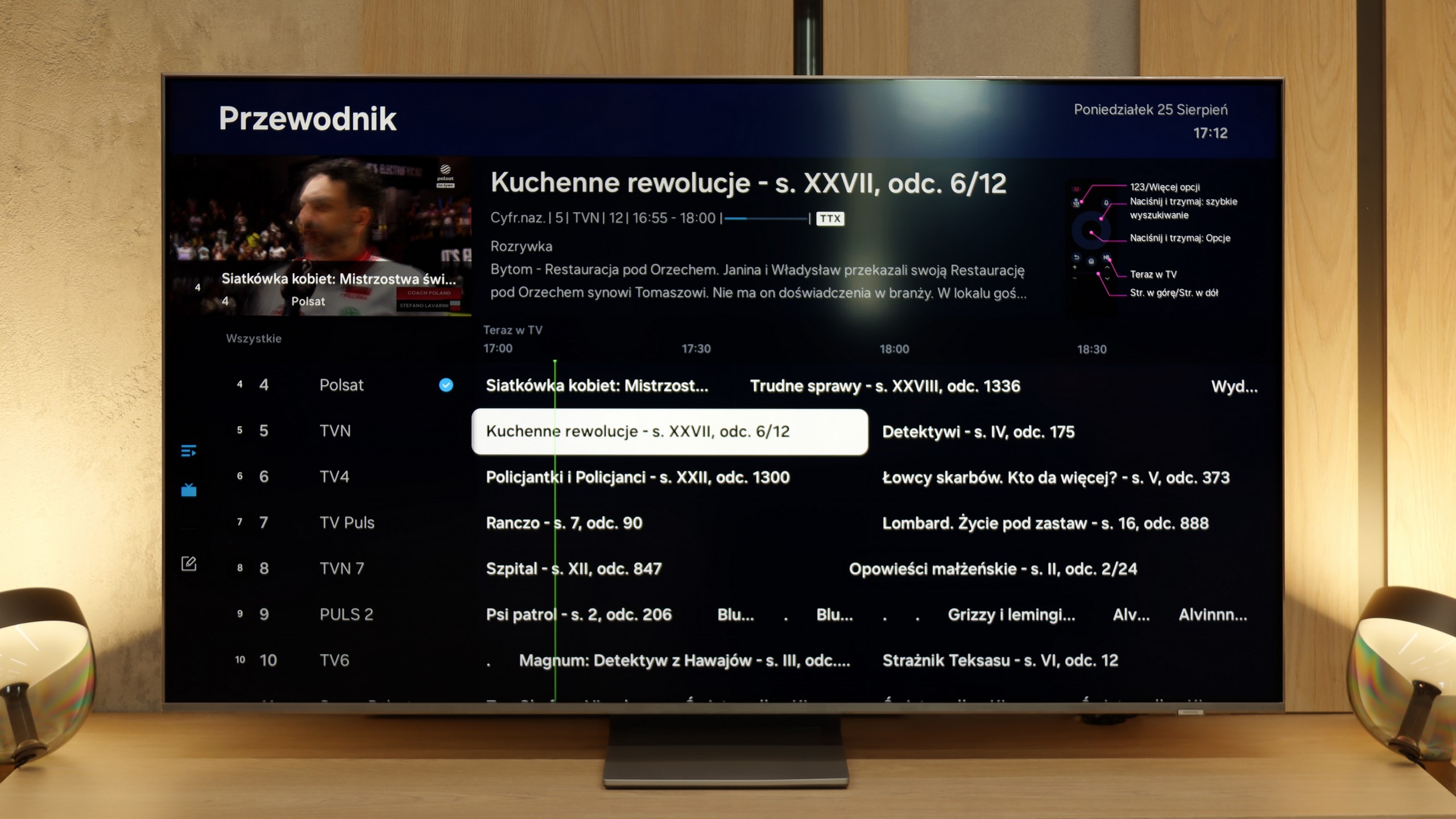
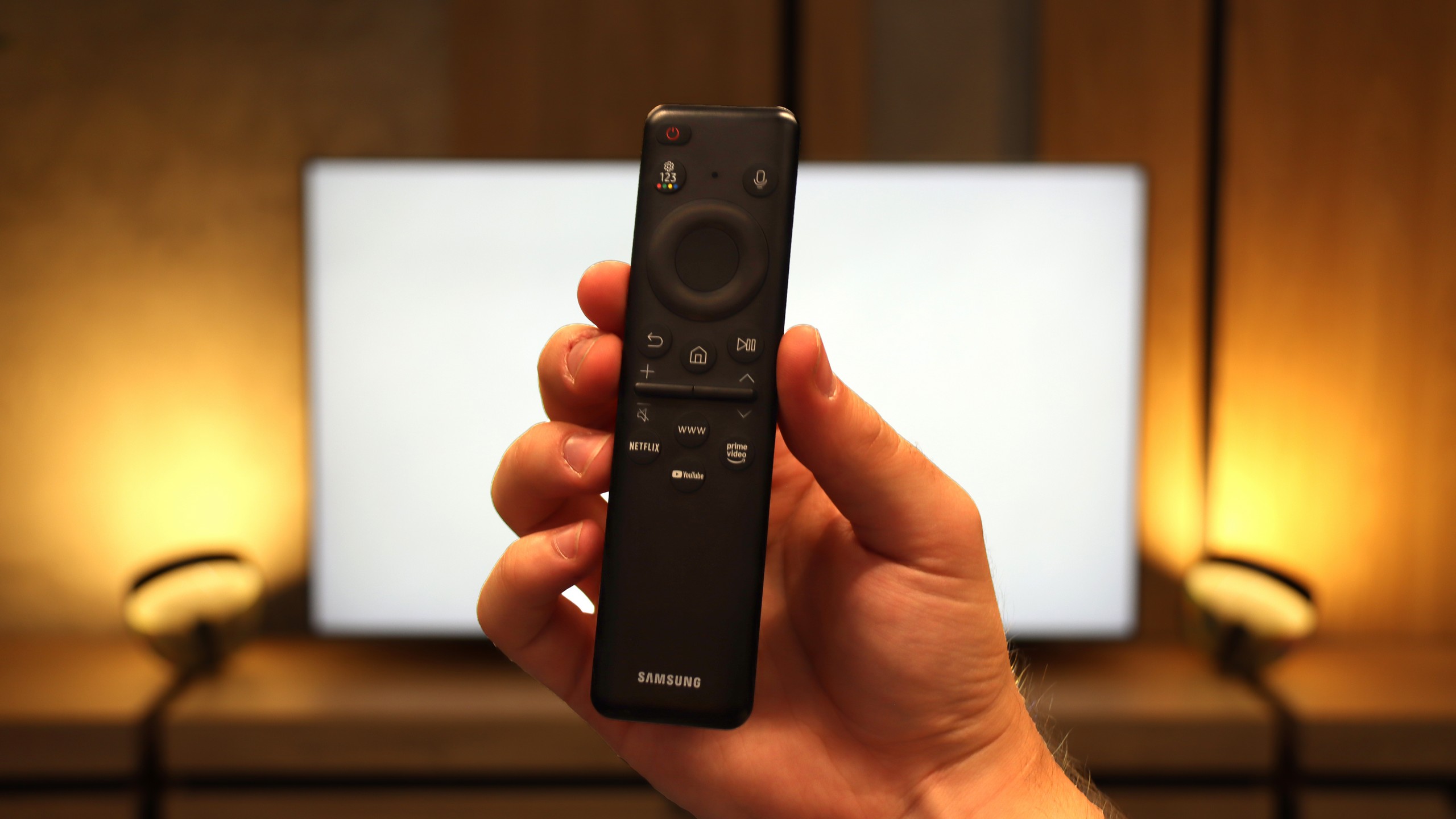
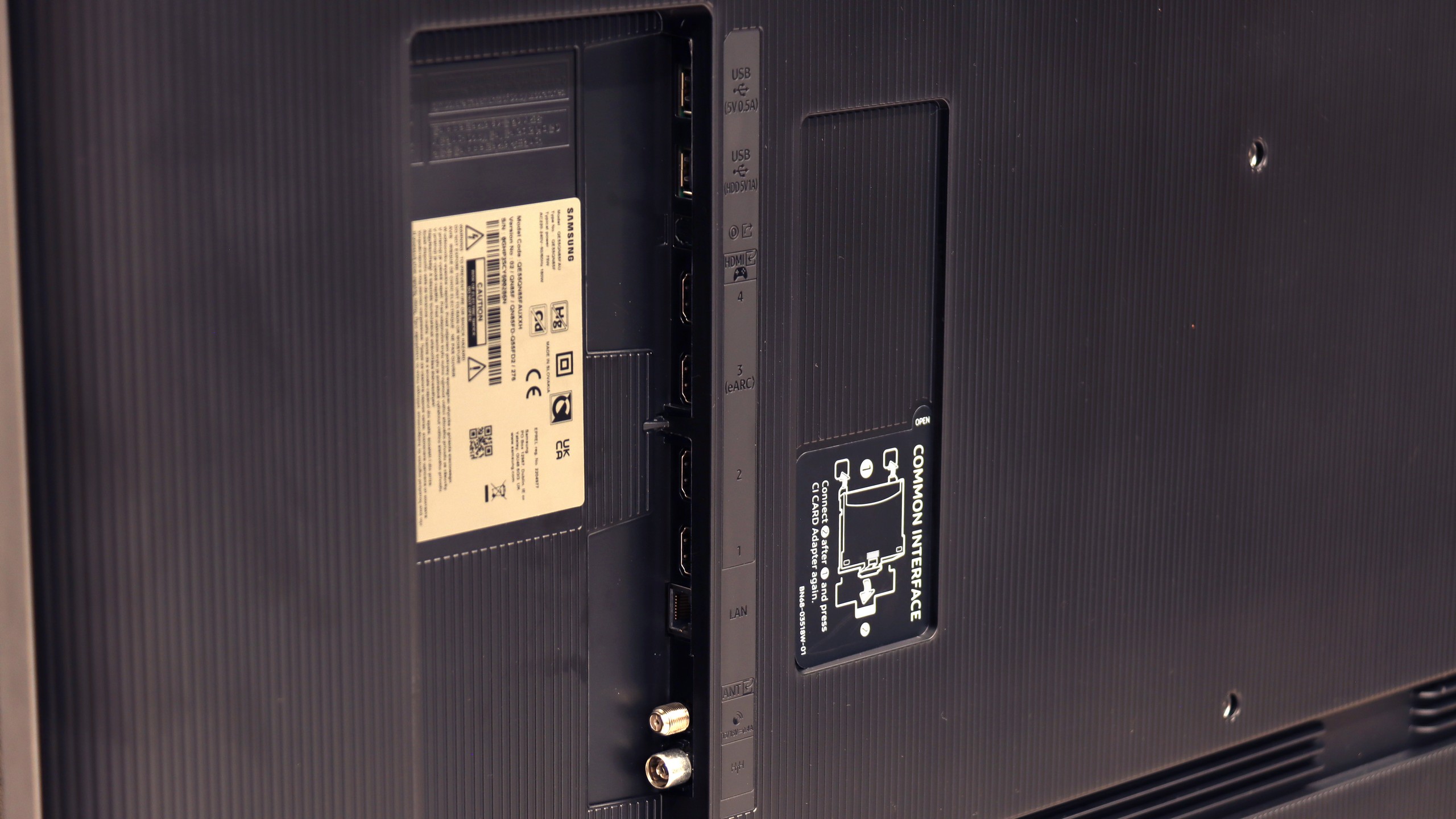
Classic TV Features
In terms of classic features, The Frame does not stand out in any way compared to the competition. There is no USB recording option or PiP (picture in picture) feature, which may be disappointing for some users. On the other hand, the TV allows for simultaneous use of speakers and headphones, which can be useful – especially for older users. The EPG, or electronic program guide, is quite readable, and despite the lack of traditional buttons on the remote, we managed to launch even the teletext. In everyday use, the basic functions work smoothly and without significant complaints.
Smart System – Tizen and Apps
The Frame 2025 runs on the Tizen operating system, which has been considered one of the most refined Smart TV solutions on the market for years. It is a system designed for devices that are more than just a television – and it was created with that spirit in mind. Tizen offers full integration with external devices – supporting both Apple AirPlay and Miracast. With the SmartThings app, it is possible to control not only the television but also other devices within the smart home. Since last year, Samsung has also been developing its own voice assistant with support for the Polish language, which significantly facilitates operation. However, the greatest strength of the Smart system in The Frame remains the Art Gallery app. Although access to it is paid (via subscription), it offers the best art scans on the market – we are talking about scans, not just ordinary photos. As a result, the effect of a digital artwork hanging on the wall looks much better than in any other lifestyle TV.
Smart TV and Tizen System
The Samsung QN85F runs on the proprietary Tizen operating system, which has been one of the strongest points of the Korean manufacturer for years. The platform operates quickly, is comprehensive, and provides access to virtually all necessary applications. We have AirPlay support, the ability to mirror the screen, voice search, and a very clear interface. Everything is controlled by a remote with a minimal number of buttons, designed to give us quick access to the most important applications.
Classic TV Features
When it comes to classic television functions, the QN85F offers a rather basic set. The EPG interface is readable and easy to use, resembling a traditional teletext program list. A downside is the lack of USB recording and the absence of PiP functionality, which Samsung offered in many other models. This is because the QN85F uses single tuners. For some people, this may be a drawback, but looking at how few viewers today use traditional linear television, it will not matter much for most users.
SmartThings and Device Support
A strong element of the entire platform is the SmartThings application. With it, we can integrate the television with other home devices—not just those from Samsung. We can connect Philips Hue or Yeelight smart lighting, video intercoms, and many other devices to the system. SmartThings also allows us to control the television without using the traditional remote— we can use the app on our smartphone, mouse mode, or gesture control if we have a Samsung smartwatch. This makes the QN85F part of a larger ecosystem and fits excellently into the trend of the IoT smart home.
Playing files from USB
9.1/10
9.1/10
Supported photo formats:
Maximum photo resolution:

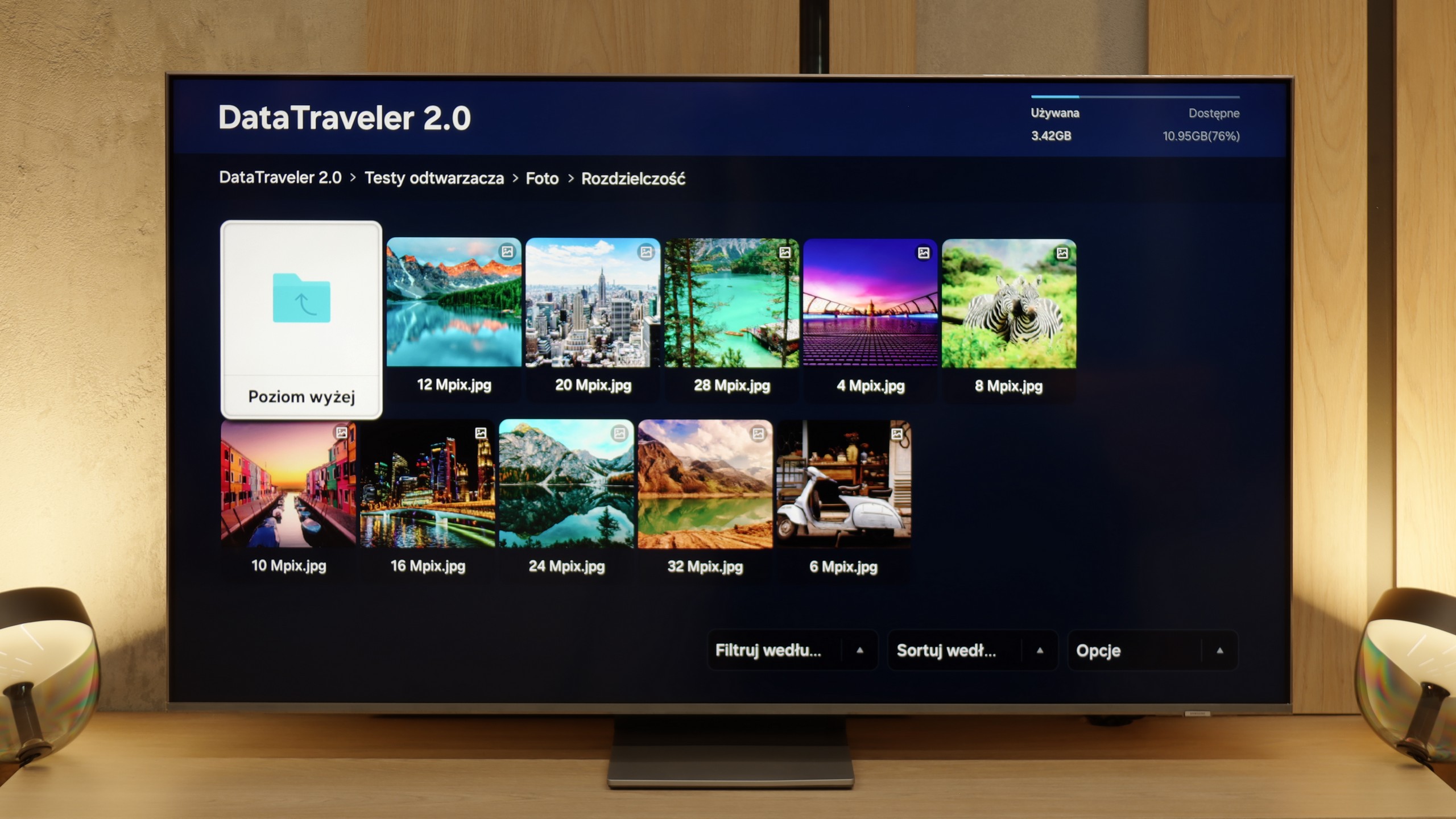
During testing, we did not notice any major problems with playing files from a USB memory. The TV handled both video materials and photos well. Of course, there are some exceptions – for example, lack of support for the HEIC format (used by Apple devices) – but it’s hard to consider this surprising. On the plus side, there is full support for high-resolution photos – the TV displays files with a high number of megapixels without any issues, which may be particularly important for those who want to treat The Frame as a digital frame as well. However, during testing, we noticed a limitation regarding subtitles – the TV only properly handled files in the .txt format. It's worth keeping this in mind and ensuring that the downloaded subtitles for movies are saved in this format, otherwise they may simply not display.
The player in the QN85F works as most people expect, supporting virtually all popular formats and is sufficiently capable even for more demanding users. Movies, music, photos – everything launches without issues. The only hiccup occurs with HEIC files, which are images from Apple devices. According to the specifications, they should work, but in practice, they simply do not open. Thumbnails are visible, but the file itself refuses to launch. This seems to be just a regular software bug. Apart from that one case, the player performs well and gives no reasons for complaints.
Apps
8.7/10
8.7/10














































Sound
6/10
7.6/10
- Maximum volume-84dB
- Dolby Digital Plus 7.1
- Dolby True HD 7.1
- Dolby Atmos in Dolby Digital Plus (JOC)
- Dolby Atmos in Dolby True HD
- DTS:X in DTS-HD MA
- DTS-HD Master Audio
For such a slim TV, the sound is quite good. It's full, sufficient for everyday viewing, but without much excitement – typical for flat designs. There's not much bass, although at times it can be heard. The speakers in a 2.0.2 configuration have a total power of 40 W (in the 55+ inch version). Unfortunately, the TV does not support DTS format, so when watching films with that audio, external equipment, such as a home theater system, must be used. You can connect a soundbar, and thanks to the Q-Symphony feature, the TV plays along with it. Samsung also offers visually matching models to The Frame like S700D or S800D, but they are sold separately. (This shouldn't surprise anyone😉).
The Samsung QN85F is equipped with a 2.2 system with a power of 40 W and performs really well for built-in speakers. The bass is pleasant, and the dialogues are clear and easy to hear even during louder scenes. Even at maximum volume, the television does not produce any unwanted vibrations, and nothing creaks. At the bottom of the housing, there is a subwoofer responsible for the bass, so it’s important to ensure that it is not obstructed during installation.
As for formats, the QN85F does not support DTS:X audio, which for Samsung has been a standard for several years now, forcing Blu-ray enthusiasts to connect audio devices first to the home theater and then to the television. In return, however, we get support for the more popular Dolby Atmos format, which can add extra space to the sound in movies and series.
Acoustic Measurements
No acoustic data
84dBC (Max)
75dBC


